IMBA Employability Skills: Employee Turnover at Jaguar Land Rover
VerifiedAdded on 2023/04/25
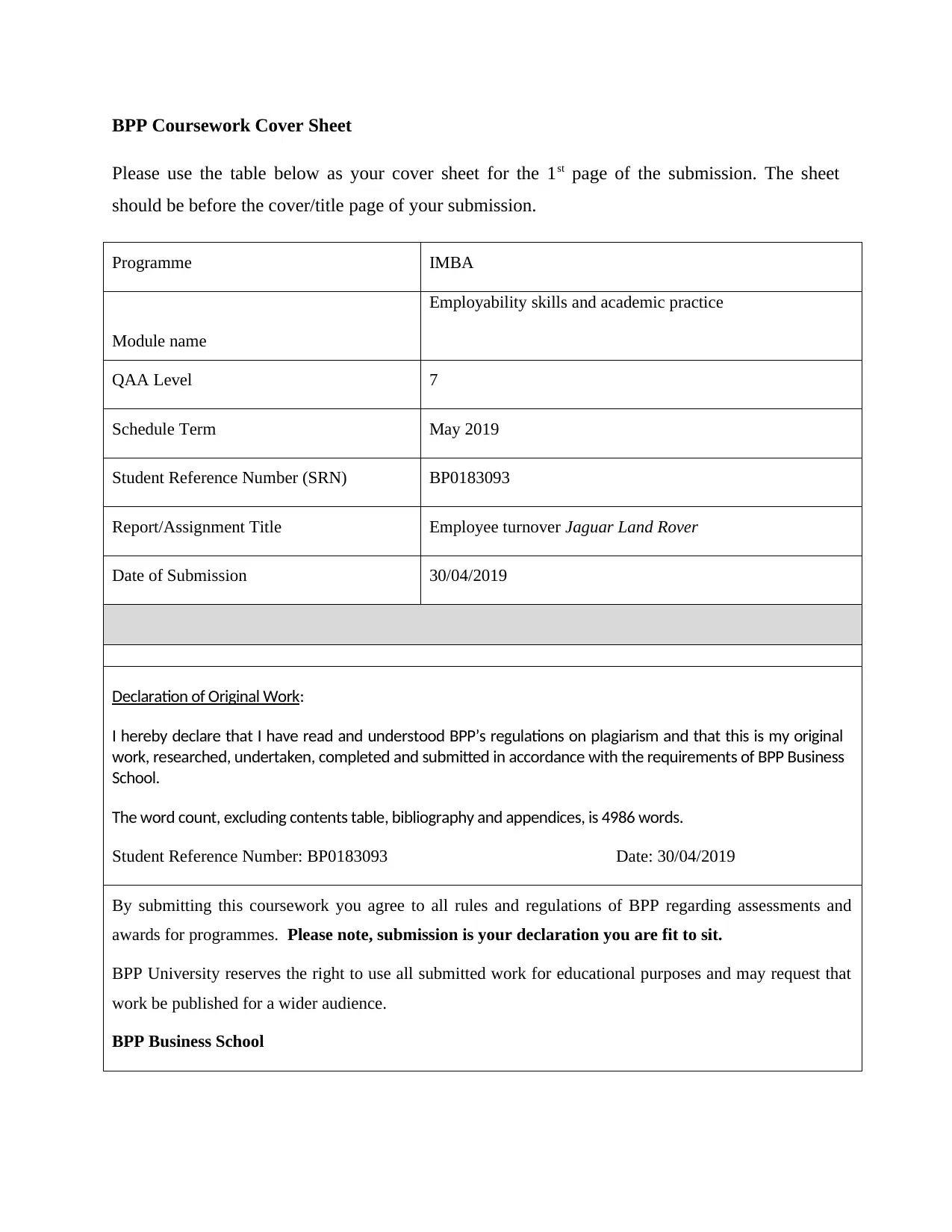
Please use the table below as your cover sheet for the 1st page of the submission. The sheet
should be before the cover/title page of your submission.
Programme IMBA
Module name
Employability skills and academic practice
QAA Level 7
Schedule Term May 2019
Student Reference Number (SRN) BP0183093
Report/Assignment Title Employee turnover Jaguar Land Rover
Date of Submission 30/04/2019
Declaration of Original Work:
I hereby declare that I have read and understood BPP’s regulations on plagiarism and that this is my original
work, researched, undertaken, completed and submitted in accordance with the requirements of BPP Business
School.
The word count, excluding contents table, bibliography and appendices, is 4986 words.
Student Reference Number: BP0183093 Date: 30/04/2019
By submitting this coursework you agree to all rules and regulations of BPP regarding assessments and
awards for programmes. Please note, submission is your declaration you are fit to sit.
BPP University reserves the right to use all submitted work for educational purposes and may request that
work be published for a wider audience.
BPP Business School
Paraphrase This Document
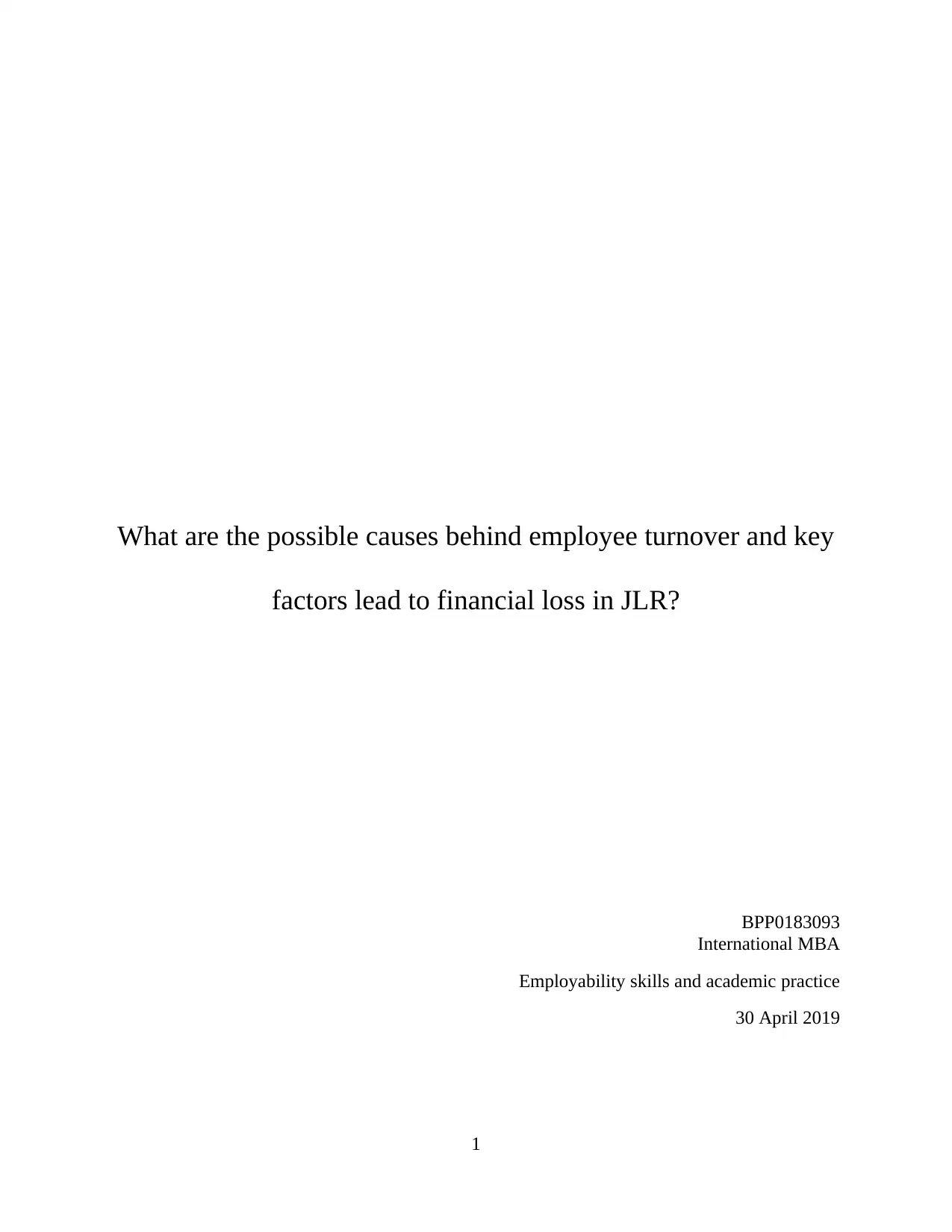
factors lead to financial loss in JLR?
BPP0183093
International MBA
Employability skills and academic practice
30 April 2019
1
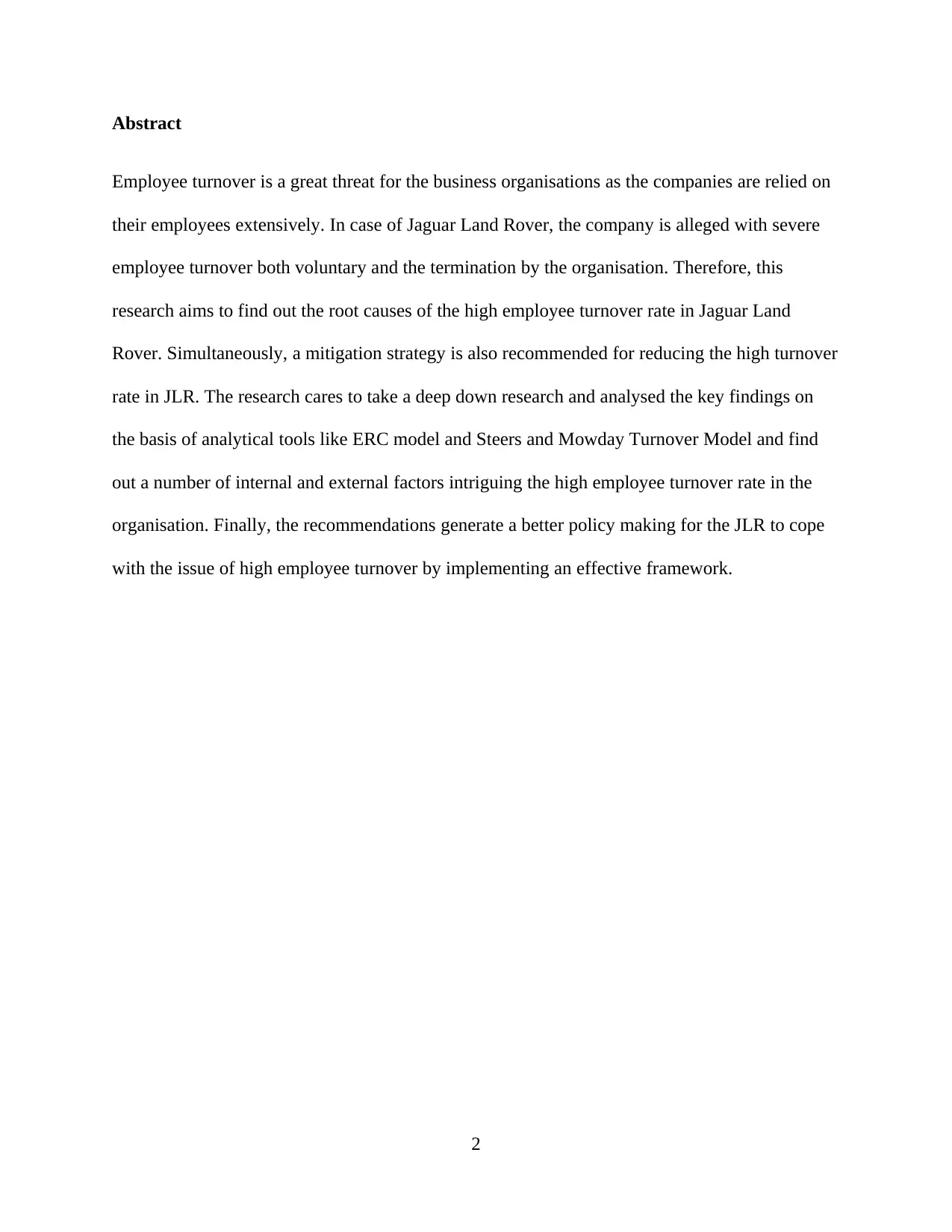
Employee turnover is a great threat for the business organisations as the companies are relied on
their employees extensively. In case of Jaguar Land Rover, the company is alleged with severe
employee turnover both voluntary and the termination by the organisation. Therefore, this
research aims to find out the root causes of the high employee turnover rate in Jaguar Land
Rover. Simultaneously, a mitigation strategy is also recommended for reducing the high turnover
rate in JLR. The research cares to take a deep down research and analysed the key findings on
the basis of analytical tools like ERC model and Steers and Mowday Turnover Model and find
out a number of internal and external factors intriguing the high employee turnover rate in the
organisation. Finally, the recommendations generate a better policy making for the JLR to cope
with the issue of high employee turnover by implementing an effective framework.
2
⊘ This is a preview!⊘
Do you want full access?
Subscribe today to unlock all pages.

Trusted by 1+ million students worldwide

1.0 Introduction................................................................................................................................5
1.1 Research aim..........................................................................................................................6
1.2 Research objectives...............................................................................................................6
1.3 Research questions.................................................................................................................6
1.4Research rationale...................................................................................................................6
2.0 Background of situation.............................................................................................................7
3.0 Research methodology...............................................................................................................8
3.1 Data collection process..........................................................................................................8
4.0 Presentation of the research.......................................................................................................9
4.1 Key findings...........................................................................................................................9
4.2 Challenges............................................................................................................................11
5.0 Analysis and findings..............................................................................................................11
5.1 ERC model of retention.......................................................................................................12
5.2 Steers and Mowday Turnover Model..................................................................................16
6.0 Conclusion and recommendations...........................................................................................20
7.0 Reference.................................................................................................................................23
Appendices....................................................................................................................................27
Appendix 1.................................................................................................................................27
Appendix 2.................................................................................................................................28
Appendix 3.................................................................................................................................29
Appendix 4.................................................................................................................................29
Appendix 5.................................................................................................................................30
3
Paraphrase This Document

Employee turnover, is considered to be a major threat for the organisations in order to damage
the company revenue particularly. Therefore, at first the notion of employee turnover should be
addressed. According to Balouch and Hassan (2014) employee turnover refers to the number or
percentage of employees or worker who leave the organisation. Moreover, Huang et al. (2016)
opined that the employee turnover in organisation can be identified as the termination of number
of employees within an organisation. In this regard, there are different reasons for employee
turnover that an organisation can face, such as many employees are highly motivated by higher
salary and willing to switch from his or her current company (Anitha 2016). Besides this, lack of
communication between the employees and the management is also considered to be a driving
factor for high employee turnover. In this context, Lu and Gursoy (2016) have highlighted that
the burden of work, conservative workplace environment, lack of transparency in the
employment policy and high market fluctuation are the major factors that creates the possible
employee turnover in an organisation.
Generally, there are two types of employee turnover in organisations in terms of involuntary and
voluntary turnover. For the voluntary turnover, the satisfaction of the employees are the principle
modes whereas for the involuntary turnover, the organisation is primarily responsible for the
termination of the employee. Moreover, the external factors are also responsible to compel the
organisation to terminate employees or the workers are forced to take voluntary resignation.
In this context, this research tries to find out the major reasons for employee turnover in Jaguar
Land Rover (JLR). In this regard, objectives of this research and research questionnaire are
linked with the research topic and deep insights of the relationship between employee turnover
4
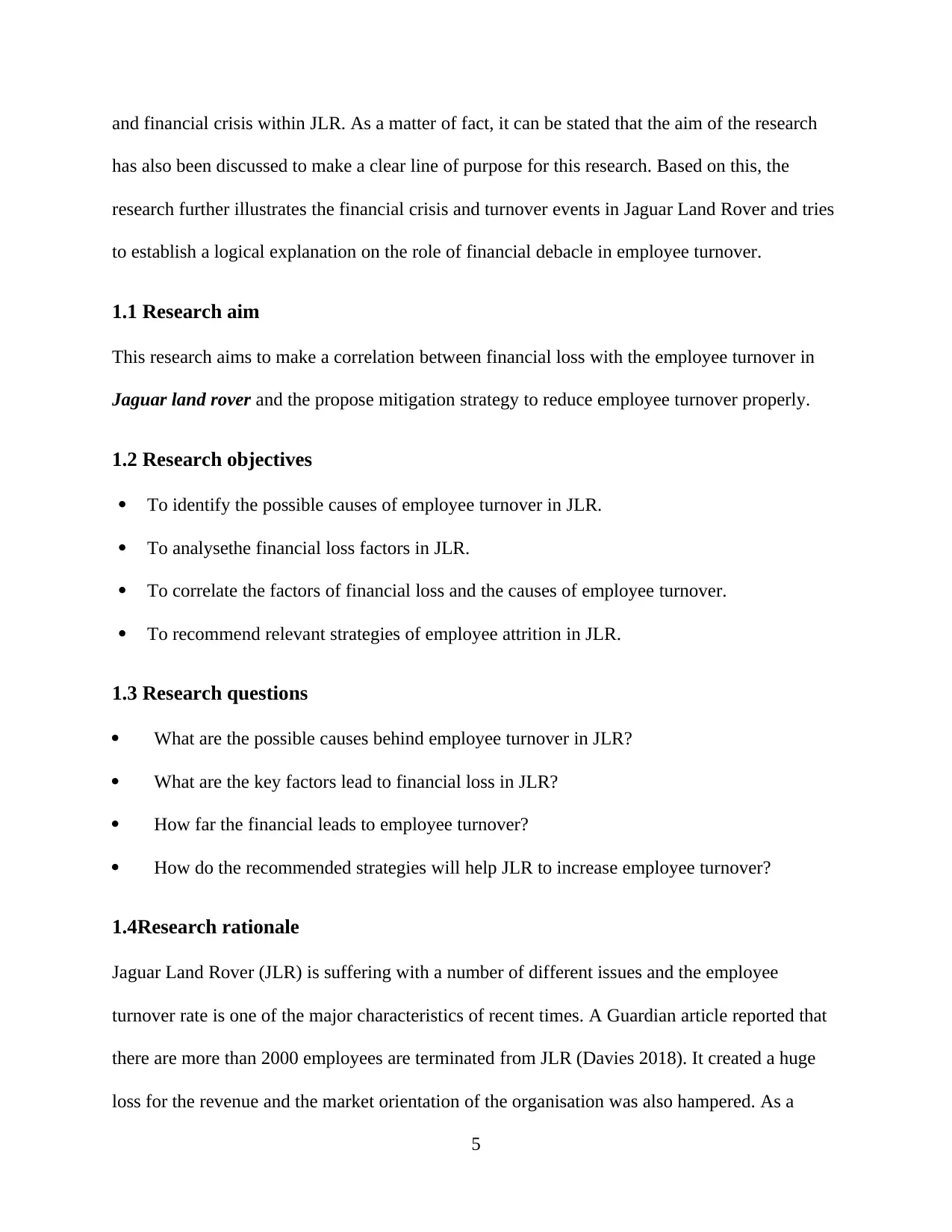
has also been discussed to make a clear line of purpose for this research. Based on this, the
research further illustrates the financial crisis and turnover events in Jaguar Land Rover and tries
to establish a logical explanation on the role of financial debacle in employee turnover.
1.1 Research aim
This research aims to make a correlation between financial loss with the employee turnover in
Jaguar land rover and the propose mitigation strategy to reduce employee turnover properly.
1.2 Research objectives
To identify the possible causes of employee turnover in JLR.
To analysethe financial loss factors in JLR.
To correlate the factors of financial loss and the causes of employee turnover.
To recommend relevant strategies of employee attrition in JLR.
1.3 Research questions
What are the possible causes behind employee turnover in JLR?
What are the key factors lead to financial loss in JLR?
How far the financial leads to employee turnover?
How do the recommended strategies will help JLR to increase employee turnover?
1.4Research rationale
Jaguar Land Rover (JLR) is suffering with a number of different issues and the employee
turnover rate is one of the major characteristics of recent times. A Guardian article reported that
there are more than 2000 employees are terminated from JLR (Davies 2018). It created a huge
loss for the revenue and the market orientation of the organisation was also hampered. As a
5
⊘ This is a preview!⊘
Do you want full access?
Subscribe today to unlock all pages.

Trusted by 1+ million students worldwide
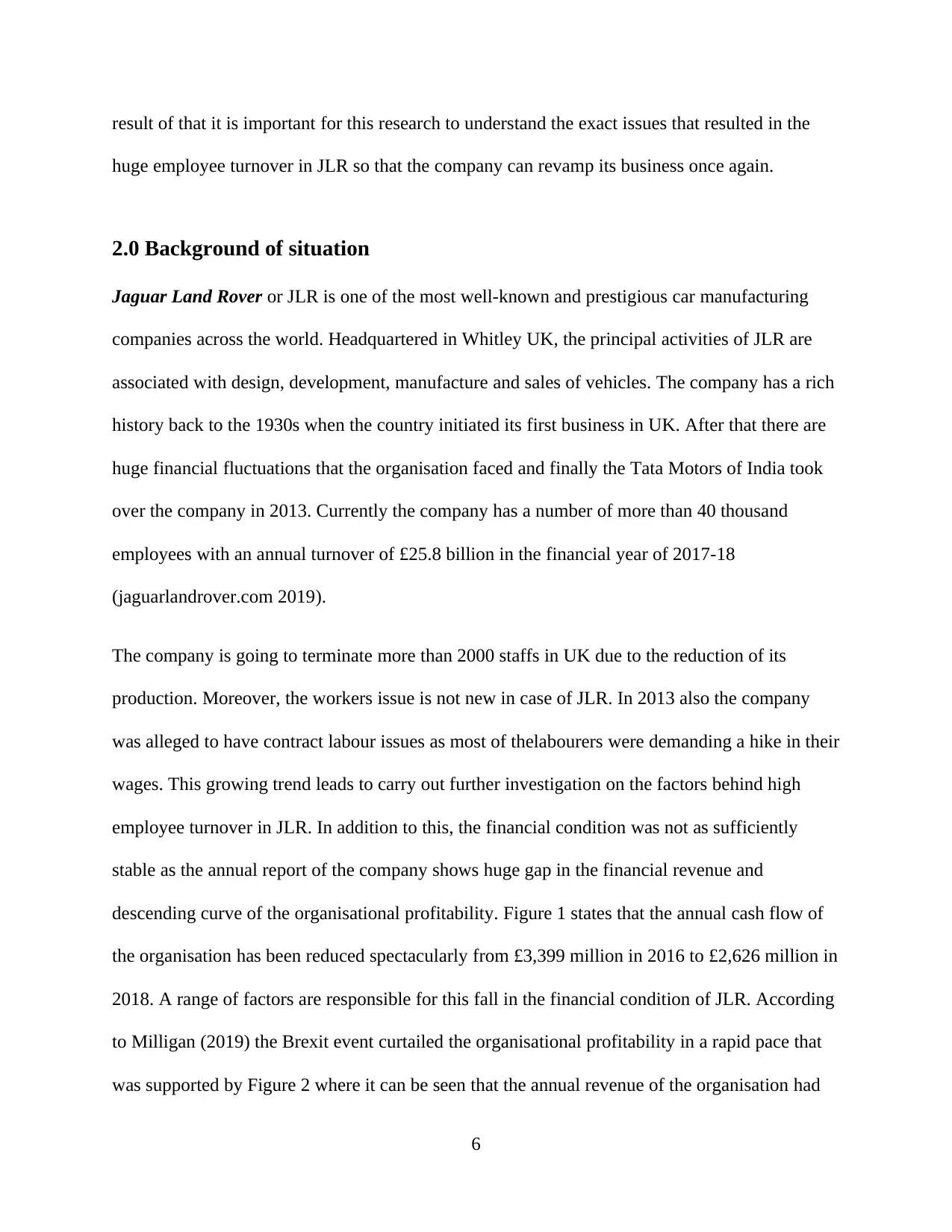
huge employee turnover in JLR so that the company can revamp its business once again.
2.0 Background of situation
Jaguar Land Rover or JLR is one of the most well-known and prestigious car manufacturing
companies across the world. Headquartered in Whitley UK, the principal activities of JLR are
associated with design, development, manufacture and sales of vehicles. The company has a rich
history back to the 1930s when the country initiated its first business in UK. After that there are
huge financial fluctuations that the organisation faced and finally the Tata Motors of India took
over the company in 2013. Currently the company has a number of more than 40 thousand
employees with an annual turnover of £25.8 billion in the financial year of 2017-18
(jaguarlandrover.com 2019).
The company is going to terminate more than 2000 staffs in UK due to the reduction of its
production. Moreover, the workers issue is not new in case of JLR. In 2013 also the company
was alleged to have contract labour issues as most of thelabourers were demanding a hike in their
wages. This growing trend leads to carry out further investigation on the factors behind high
employee turnover in JLR. In addition to this, the financial condition was not as sufficiently
stable as the annual report of the company shows huge gap in the financial revenue and
descending curve of the organisational profitability. Figure 1 states that the annual cash flow of
the organisation has been reduced spectacularly from £3,399 million in 2016 to £2,626 million in
2018. A range of factors are responsible for this fall in the financial condition of JLR. According
to Milligan (2019) the Brexit event curtailed the organisational profitability in a rapid pace that
was supported by Figure 2 where it can be seen that the annual revenue of the organisation had
6
Paraphrase This Document
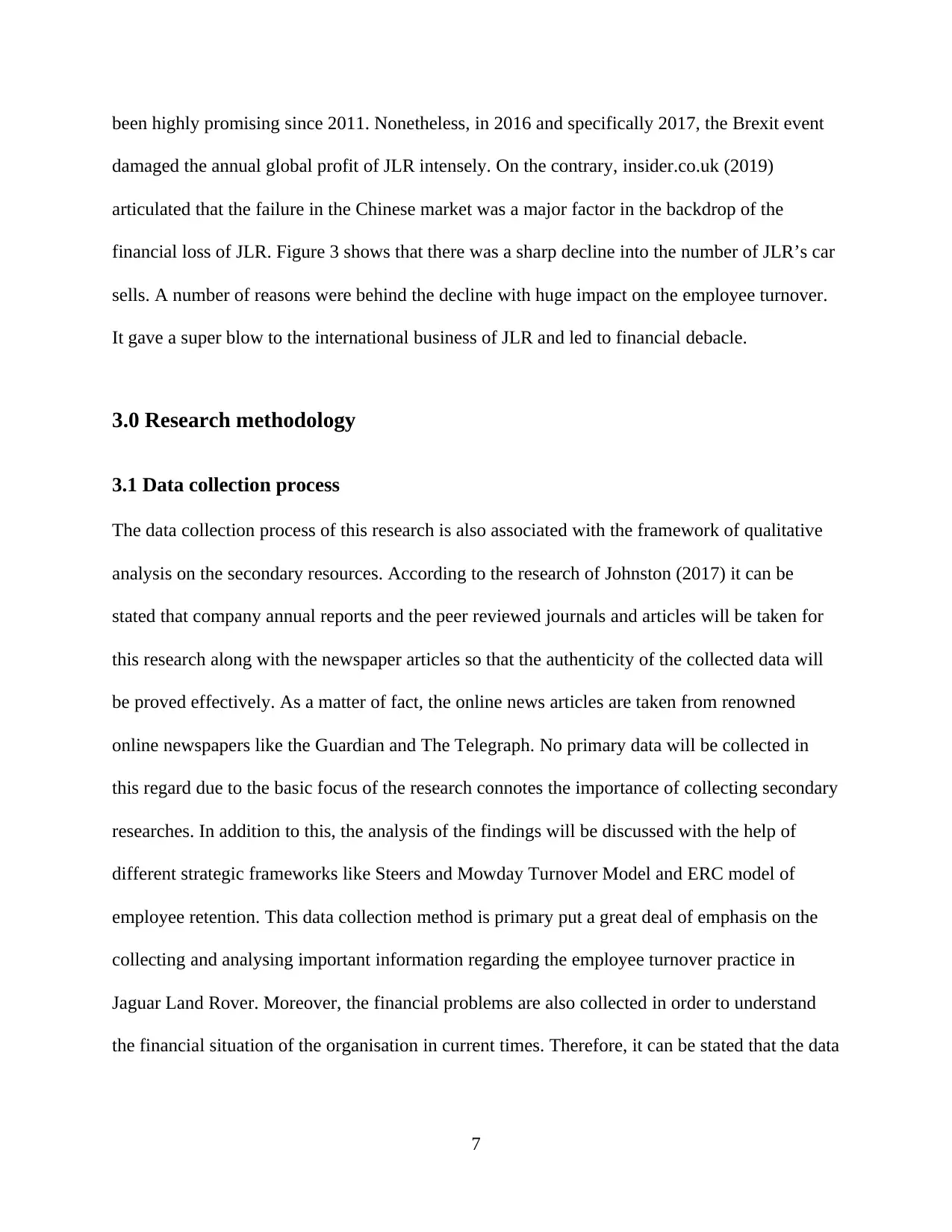
damaged the annual global profit of JLR intensely. On the contrary, insider.co.uk (2019)
articulated that the failure in the Chinese market was a major factor in the backdrop of the
financial loss of JLR. Figure 3 shows that there was a sharp decline into the number of JLR’s car
sells. A number of reasons were behind the decline with huge impact on the employee turnover.
It gave a super blow to the international business of JLR and led to financial debacle.
3.0 Research methodology
3.1 Data collection process
The data collection process of this research is also associated with the framework of qualitative
analysis on the secondary resources. According to the research of Johnston (2017) it can be
stated that company annual reports and the peer reviewed journals and articles will be taken for
this research along with the newspaper articles so that the authenticity of the collected data will
be proved effectively. As a matter of fact, the online news articles are taken from renowned
online newspapers like the Guardian and The Telegraph. No primary data will be collected in
this regard due to the basic focus of the research connotes the importance of collecting secondary
researches. In addition to this, the analysis of the findings will be discussed with the help of
different strategic frameworks like Steers and Mowday Turnover Model and ERC model of
employee retention. This data collection method is primary put a great deal of emphasis on the
collecting and analysing important information regarding the employee turnover practice in
Jaguar Land Rover. Moreover, the financial problems are also collected in order to understand
the financial situation of the organisation in current times. Therefore, it can be stated that the data
7
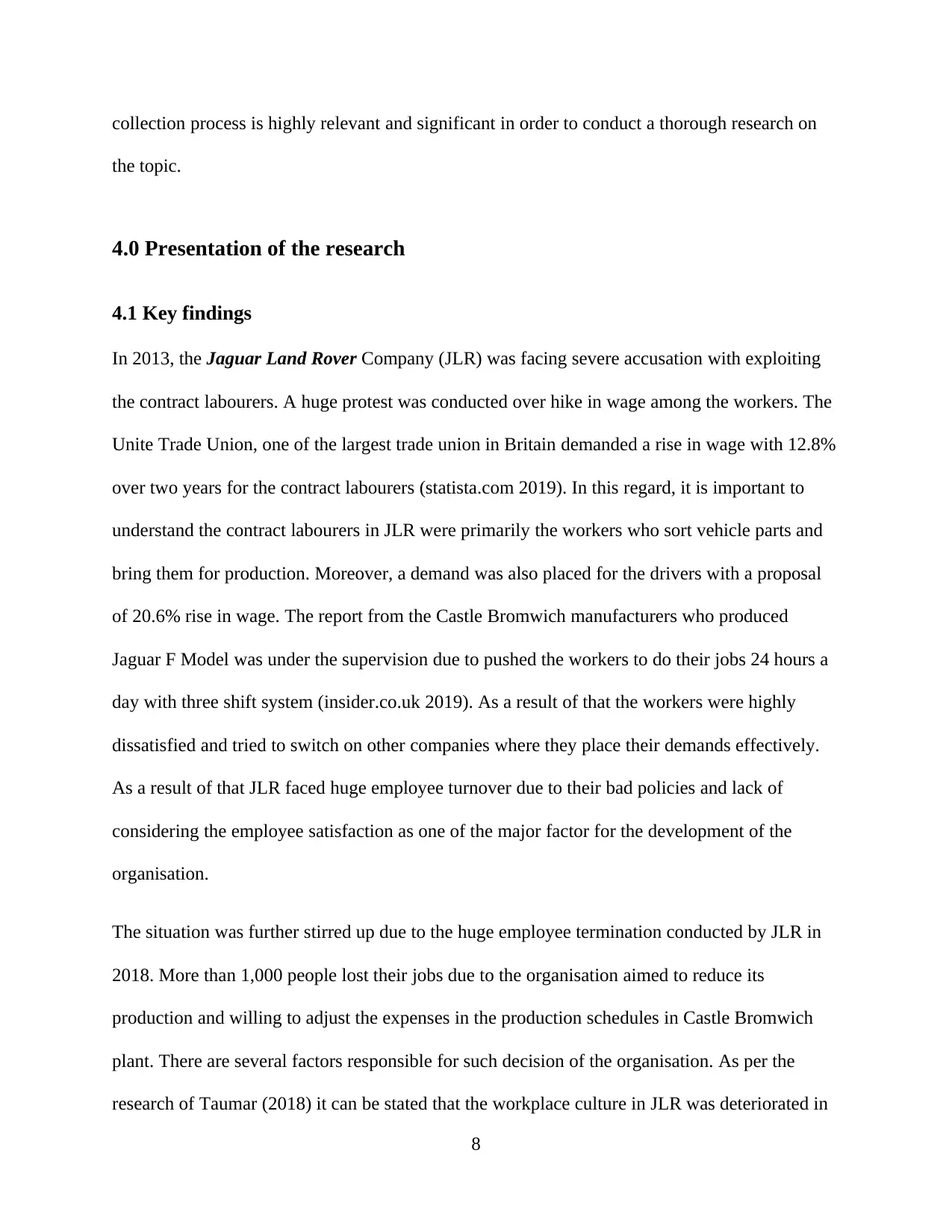
the topic.
4.0 Presentation of the research
4.1 Key findings
In 2013, the Jaguar Land Rover Company (JLR) was facing severe accusation with exploiting
the contract labourers. A huge protest was conducted over hike in wage among the workers. The
Unite Trade Union, one of the largest trade union in Britain demanded a rise in wage with 12.8%
over two years for the contract labourers (statista.com 2019). In this regard, it is important to
understand the contract labourers in JLR were primarily the workers who sort vehicle parts and
bring them for production. Moreover, a demand was also placed for the drivers with a proposal
of 20.6% rise in wage. The report from the Castle Bromwich manufacturers who produced
Jaguar F Model was under the supervision due to pushed the workers to do their jobs 24 hours a
day with three shift system (insider.co.uk 2019). As a result of that the workers were highly
dissatisfied and tried to switch on other companies where they place their demands effectively.
As a result of that JLR faced huge employee turnover due to their bad policies and lack of
considering the employee satisfaction as one of the major factor for the development of the
organisation.
The situation was further stirred up due to the huge employee termination conducted by JLR in
2018. More than 1,000 people lost their jobs due to the organisation aimed to reduce its
production and willing to adjust the expenses in the production schedules in Castle Bromwich
plant. There are several factors responsible for such decision of the organisation. As per the
research of Taumar (2018) it can be stated that the workplace culture in JLR was deteriorated in
8
⊘ This is a preview!⊘
Do you want full access?
Subscribe today to unlock all pages.

Trusted by 1+ million students worldwide
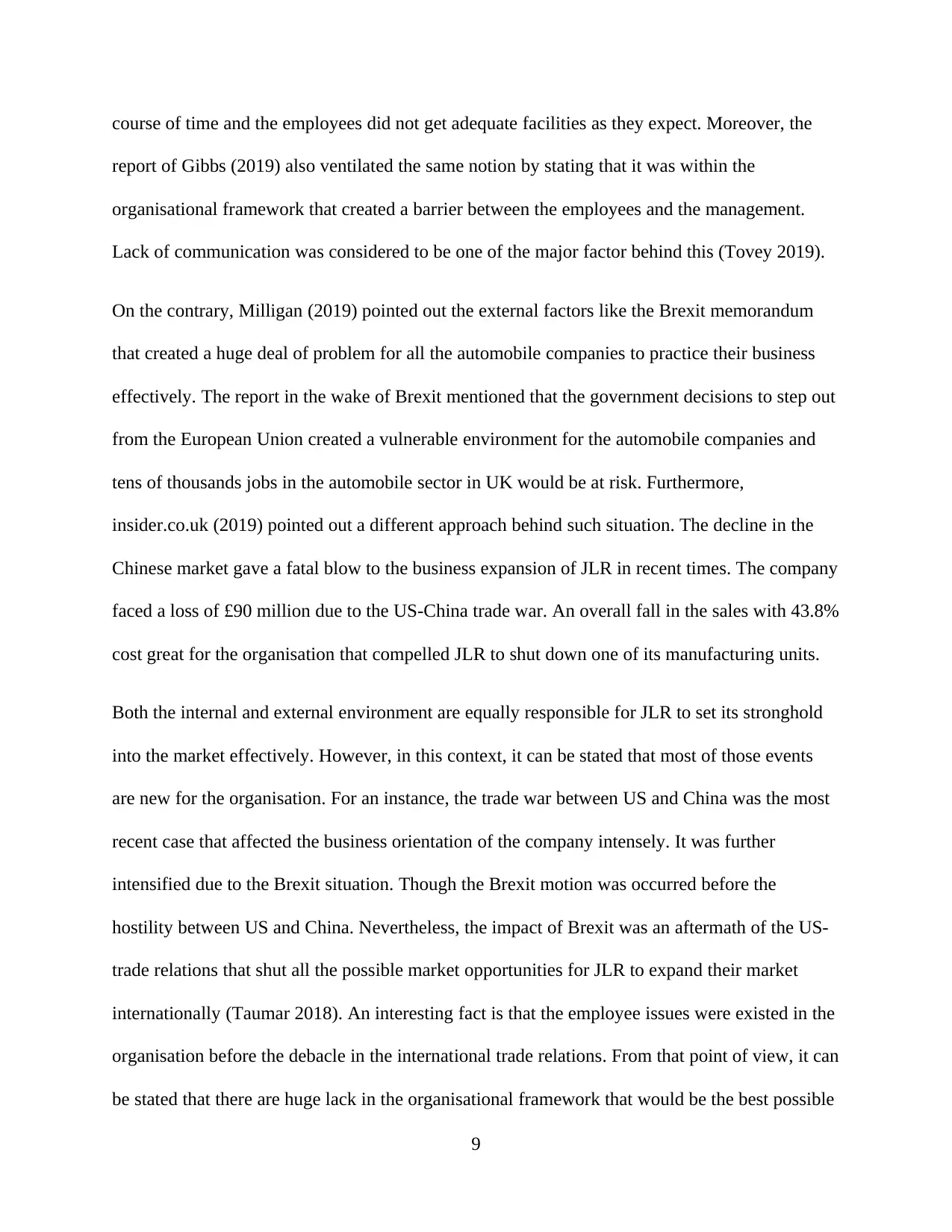
report of Gibbs (2019) also ventilated the same notion by stating that it was within the
organisational framework that created a barrier between the employees and the management.
Lack of communication was considered to be one of the major factor behind this (Tovey 2019).
On the contrary, Milligan (2019) pointed out the external factors like the Brexit memorandum
that created a huge deal of problem for all the automobile companies to practice their business
effectively. The report in the wake of Brexit mentioned that the government decisions to step out
from the European Union created a vulnerable environment for the automobile companies and
tens of thousands jobs in the automobile sector in UK would be at risk. Furthermore,
insider.co.uk (2019) pointed out a different approach behind such situation. The decline in the
Chinese market gave a fatal blow to the business expansion of JLR in recent times. The company
faced a loss of £90 million due to the US-China trade war. An overall fall in the sales with 43.8%
cost great for the organisation that compelled JLR to shut down one of its manufacturing units.
Both the internal and external environment are equally responsible for JLR to set its stronghold
into the market effectively. However, in this context, it can be stated that most of those events
are new for the organisation. For an instance, the trade war between US and China was the most
recent case that affected the business orientation of the company intensely. It was further
intensified due to the Brexit situation. Though the Brexit motion was occurred before the
hostility between US and China. Nevertheless, the impact of Brexit was an aftermath of the US-
trade relations that shut all the possible market opportunities for JLR to expand their market
internationally (Taumar 2018). An interesting fact is that the employee issues were existed in the
organisation before the debacle in the international trade relations. From that point of view, it can
be stated that there are huge lack in the organisational framework that would be the best possible
9
Paraphrase This Document
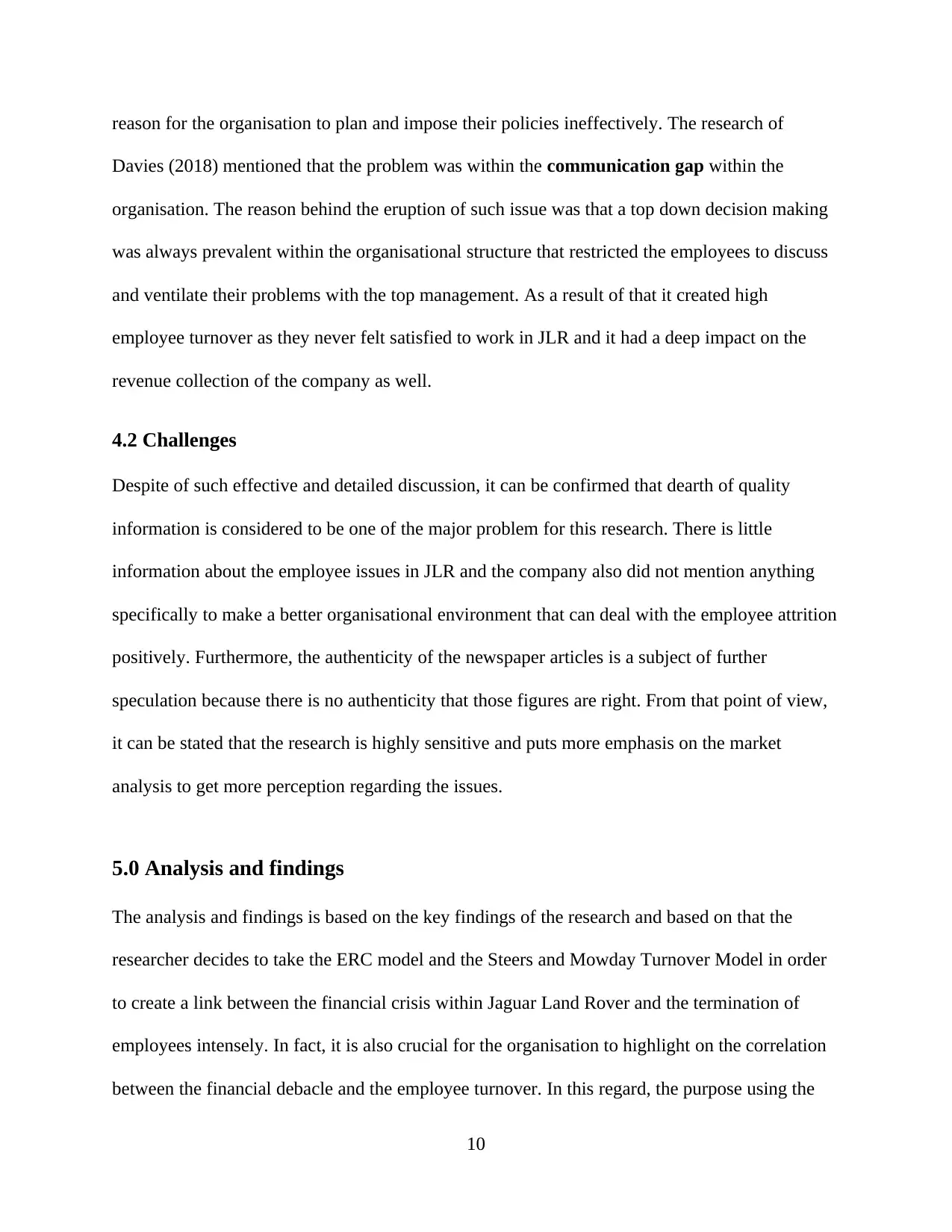
Davies (2018) mentioned that the problem was within the communication gap within the
organisation. The reason behind the eruption of such issue was that a top down decision making
was always prevalent within the organisational structure that restricted the employees to discuss
and ventilate their problems with the top management. As a result of that it created high
employee turnover as they never felt satisfied to work in JLR and it had a deep impact on the
revenue collection of the company as well.
4.2 Challenges
Despite of such effective and detailed discussion, it can be confirmed that dearth of quality
information is considered to be one of the major problem for this research. There is little
information about the employee issues in JLR and the company also did not mention anything
specifically to make a better organisational environment that can deal with the employee attrition
positively. Furthermore, the authenticity of the newspaper articles is a subject of further
speculation because there is no authenticity that those figures are right. From that point of view,
it can be stated that the research is highly sensitive and puts more emphasis on the market
analysis to get more perception regarding the issues.
5.0 Analysis and findings
The analysis and findings is based on the key findings of the research and based on that the
researcher decides to take the ERC model and the Steers and Mowday Turnover Model in order
to create a link between the financial crisis within Jaguar Land Rover and the termination of
employees intensely. In fact, it is also crucial for the organisation to highlight on the correlation
between the financial debacle and the employee turnover. In this regard, the purpose using the
10
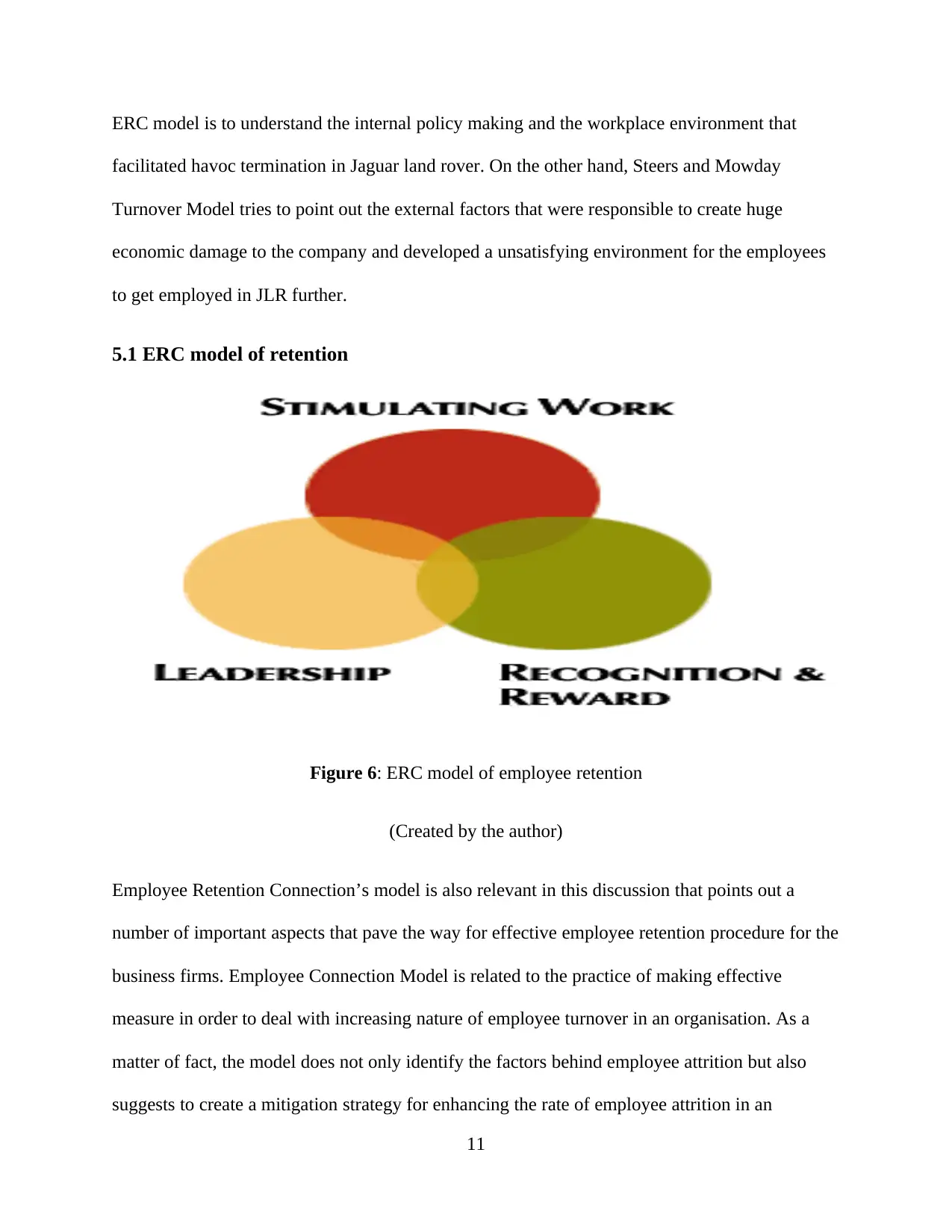
facilitated havoc termination in Jaguar land rover. On the other hand, Steers and Mowday
Turnover Model tries to point out the external factors that were responsible to create huge
economic damage to the company and developed a unsatisfying environment for the employees
to get employed in JLR further.
5.1 ERC model of retention
Figure 6: ERC model of employee retention
(Created by the author)
Employee Retention Connection’s model is also relevant in this discussion that points out a
number of important aspects that pave the way for effective employee retention procedure for the
business firms. Employee Connection Model is related to the practice of making effective
measure in order to deal with increasing nature of employee turnover in an organisation. As a
matter of fact, the model does not only identify the factors behind employee attrition but also
suggests to create a mitigation strategy for enhancing the rate of employee attrition in an
11
⊘ This is a preview!⊘
Do you want full access?
Subscribe today to unlock all pages.

Trusted by 1+ million students worldwide
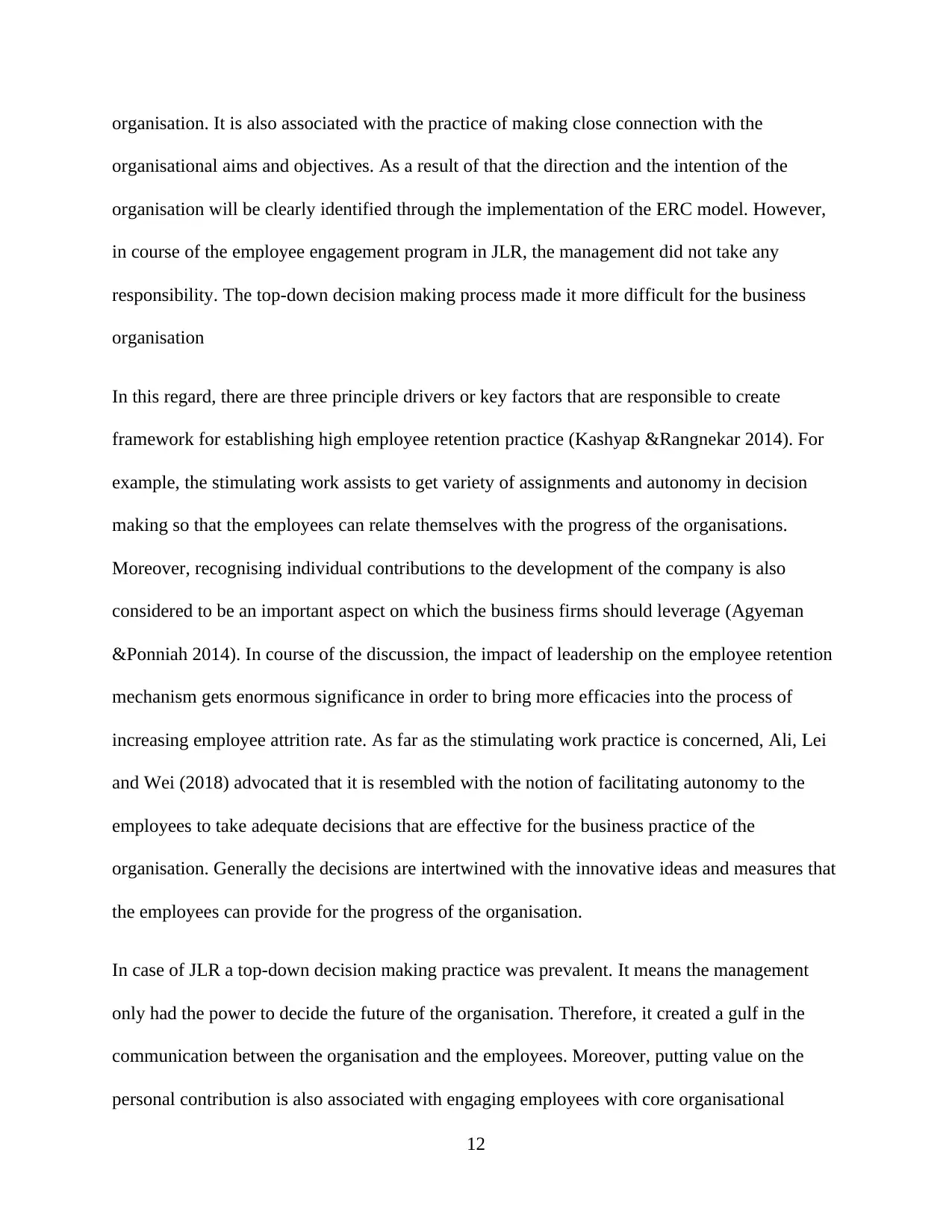
organisational aims and objectives. As a result of that the direction and the intention of the
organisation will be clearly identified through the implementation of the ERC model. However,
in course of the employee engagement program in JLR, the management did not take any
responsibility. The top-down decision making process made it more difficult for the business
organisation
In this regard, there are three principle drivers or key factors that are responsible to create
framework for establishing high employee retention practice (Kashyap &Rangnekar 2014). For
example, the stimulating work assists to get variety of assignments and autonomy in decision
making so that the employees can relate themselves with the progress of the organisations.
Moreover, recognising individual contributions to the development of the company is also
considered to be an important aspect on which the business firms should leverage (Agyeman
&Ponniah 2014). In course of the discussion, the impact of leadership on the employee retention
mechanism gets enormous significance in order to bring more efficacies into the process of
increasing employee attrition rate. As far as the stimulating work practice is concerned, Ali, Lei
and Wei (2018) advocated that it is resembled with the notion of facilitating autonomy to the
employees to take adequate decisions that are effective for the business practice of the
organisation. Generally the decisions are intertwined with the innovative ideas and measures that
the employees can provide for the progress of the organisation.
In case of JLR a top-down decision making practice was prevalent. It means the management
only had the power to decide the future of the organisation. Therefore, it created a gulf in the
communication between the organisation and the employees. Moreover, putting value on the
personal contribution is also associated with engaging employees with core organisational
12
Paraphrase This Document
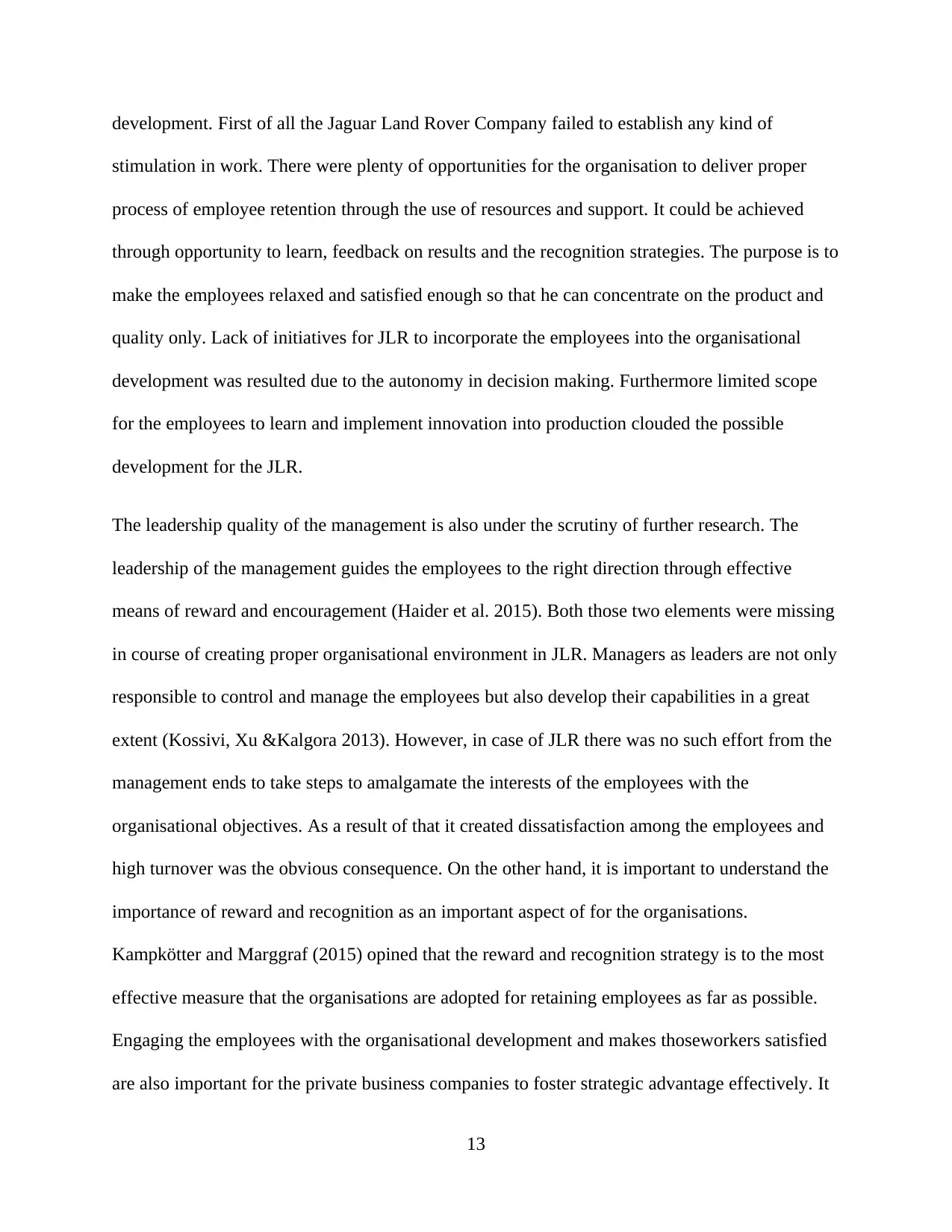
stimulation in work. There were plenty of opportunities for the organisation to deliver proper
process of employee retention through the use of resources and support. It could be achieved
through opportunity to learn, feedback on results and the recognition strategies. The purpose is to
make the employees relaxed and satisfied enough so that he can concentrate on the product and
quality only. Lack of initiatives for JLR to incorporate the employees into the organisational
development was resulted due to the autonomy in decision making. Furthermore limited scope
for the employees to learn and implement innovation into production clouded the possible
development for the JLR.
The leadership quality of the management is also under the scrutiny of further research. The
leadership of the management guides the employees to the right direction through effective
means of reward and encouragement (Haider et al. 2015). Both those two elements were missing
in course of creating proper organisational environment in JLR. Managers as leaders are not only
responsible to control and manage the employees but also develop their capabilities in a great
extent (Kossivi, Xu &Kalgora 2013). However, in case of JLR there was no such effort from the
management ends to take steps to amalgamate the interests of the employees with the
organisational objectives. As a result of that it created dissatisfaction among the employees and
high turnover was the obvious consequence. On the other hand, it is important to understand the
importance of reward and recognition as an important aspect of for the organisations.
Kampkötter and Marggraf (2015) opined that the reward and recognition strategy is to the most
effective measure that the organisations are adopted for retaining employees as far as possible.
Engaging the employees with the organisational development and makes thoseworkers satisfied
are also important for the private business companies to foster strategic advantage effectively. It
13

recognition policy that was possible for the or4ganisation to enhance employee turnover.
Indiscrimination and preferential measures were prevalent within the organisation that worsened
the satisfaction level of the JLR employees specifically the contractual workers on the verge of
resignation.
In this context, economictimes.indiatimes.com (2018) articulated that the employee benefits and
pay offers are not transparent enou8gh and comparatively low in the UK market. It can be argued
that the organisation is highly influenced by its reduction of employee payments and benefits.
The reason behind such an initiative was behind the fall in profitability. The 2013 profitability
was estimated £2.5 billion which was reduced to £1 billion in 2014. The management questioned
the workforce’s contribution to the organisational aspect. Moreover, the pension cuts was also
proposed to reduce £240 million (Gibbs 2016). It is clearly proved that the management decision
making was not effective enough to satisfy the employee expectations. Moreover, it can be
articulated that there are huge communication gap between the organisational objectives and the
aspirations of the employees. Therefore, it created a problem for the organisation to retain its
employees as the employees were not only dissatisfied with the management decisions but also
wanted to leave the organisation as they did not feel it legitimate to work with Jaguar Land
Rover.
14
⊘ This is a preview!⊘
Do you want full access?
Subscribe today to unlock all pages.

Trusted by 1+ million students worldwide

Figure 5: Steers and Mowday Turnover Model
(Created by the author)
The turnover model of Steers and Mowday is one of the classical concepts of employee turnover
furbished on the voluntary turnover of employees. This turnover model tried to project different
factors that influenced the turnover the employees (Ha et al 2014). One of the important
paradigms that this model proposed was the presence of external factors in employee turnover
(Hom et al. 2017). The external factors can be identified in terms of the political and economic
crisis or any socio-cultural linkages that contributed to the high rate of employee turnover
15
Paraphrase This Document
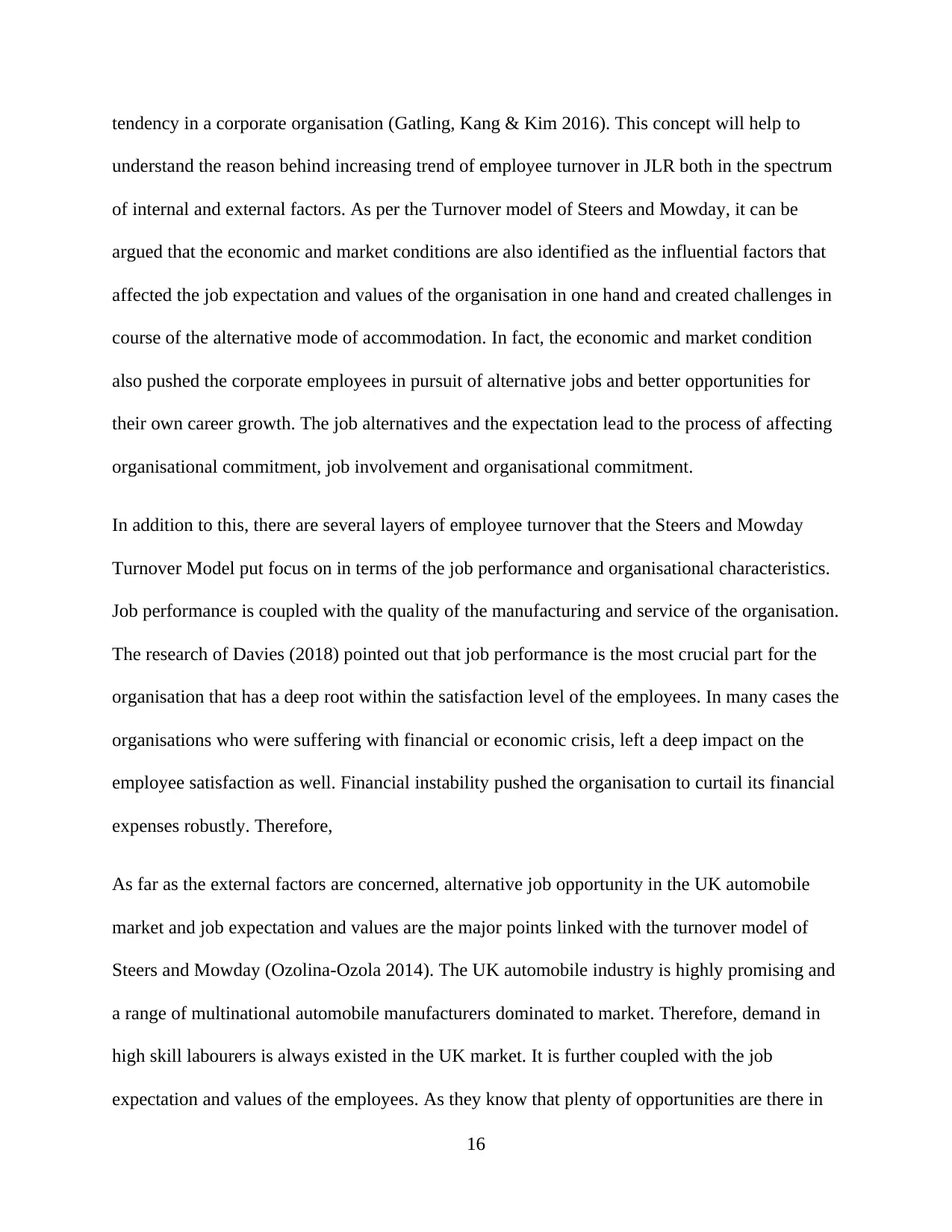
understand the reason behind increasing trend of employee turnover in JLR both in the spectrum
of internal and external factors. As per the Turnover model of Steers and Mowday, it can be
argued that the economic and market conditions are also identified as the influential factors that
affected the job expectation and values of the organisation in one hand and created challenges in
course of the alternative mode of accommodation. In fact, the economic and market condition
also pushed the corporate employees in pursuit of alternative jobs and better opportunities for
their own career growth. The job alternatives and the expectation lead to the process of affecting
organisational commitment, job involvement and organisational commitment.
In addition to this, there are several layers of employee turnover that the Steers and Mowday
Turnover Model put focus on in terms of the job performance and organisational characteristics.
Job performance is coupled with the quality of the manufacturing and service of the organisation.
The research of Davies (2018) pointed out that job performance is the most crucial part for the
organisation that has a deep root within the satisfaction level of the employees. In many cases the
organisations who were suffering with financial or economic crisis, left a deep impact on the
employee satisfaction as well. Financial instability pushed the organisation to curtail its financial
expenses robustly. Therefore,
As far as the external factors are concerned, alternative job opportunity in the UK automobile
market and job expectation and values are the major points linked with the turnover model of
Steers and Mowday (Ozolina-Ozola 2014). The UK automobile industry is highly promising and
a range of multinational automobile manufacturers dominated to market. Therefore, demand in
high skill labourers is always existed in the UK market. It is further coupled with the job
expectation and values of the employees. As they know that plenty of opportunities are there in
16
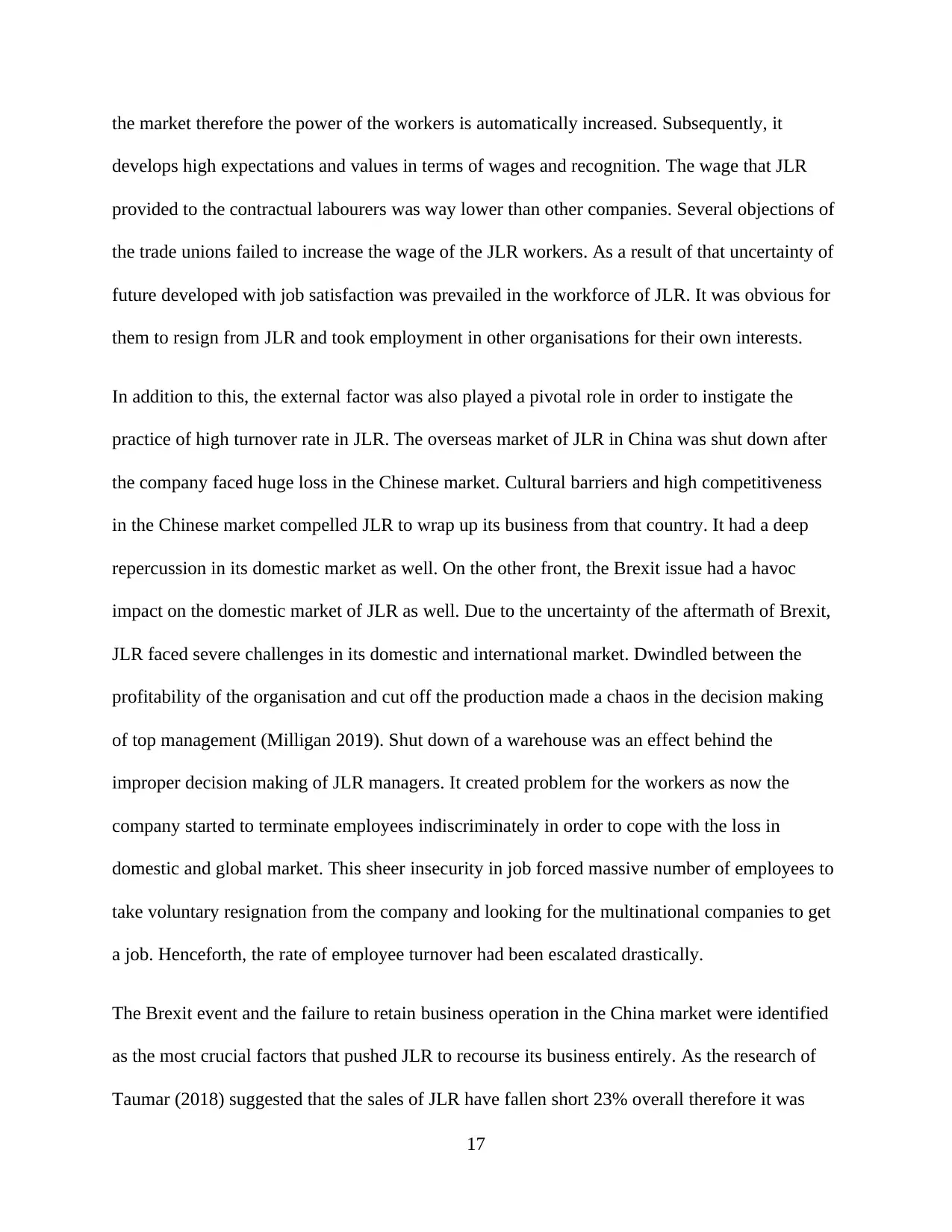
develops high expectations and values in terms of wages and recognition. The wage that JLR
provided to the contractual labourers was way lower than other companies. Several objections of
the trade unions failed to increase the wage of the JLR workers. As a result of that uncertainty of
future developed with job satisfaction was prevailed in the workforce of JLR. It was obvious for
them to resign from JLR and took employment in other organisations for their own interests.
In addition to this, the external factor was also played a pivotal role in order to instigate the
practice of high turnover rate in JLR. The overseas market of JLR in China was shut down after
the company faced huge loss in the Chinese market. Cultural barriers and high competitiveness
in the Chinese market compelled JLR to wrap up its business from that country. It had a deep
repercussion in its domestic market as well. On the other front, the Brexit issue had a havoc
impact on the domestic market of JLR as well. Due to the uncertainty of the aftermath of Brexit,
JLR faced severe challenges in its domestic and international market. Dwindled between the
profitability of the organisation and cut off the production made a chaos in the decision making
of top management (Milligan 2019). Shut down of a warehouse was an effect behind the
improper decision making of JLR managers. It created problem for the workers as now the
company started to terminate employees indiscriminately in order to cope with the loss in
domestic and global market. This sheer insecurity in job forced massive number of employees to
take voluntary resignation from the company and looking for the multinational companies to get
a job. Henceforth, the rate of employee turnover had been escalated drastically.
The Brexit event and the failure to retain business operation in the China market were identified
as the most crucial factors that pushed JLR to recourse its business entirely. As the research of
Taumar (2018) suggested that the sales of JLR have fallen short 23% overall therefore it was
17
⊘ This is a preview!⊘
Do you want full access?
Subscribe today to unlock all pages.

Trusted by 1+ million students worldwide
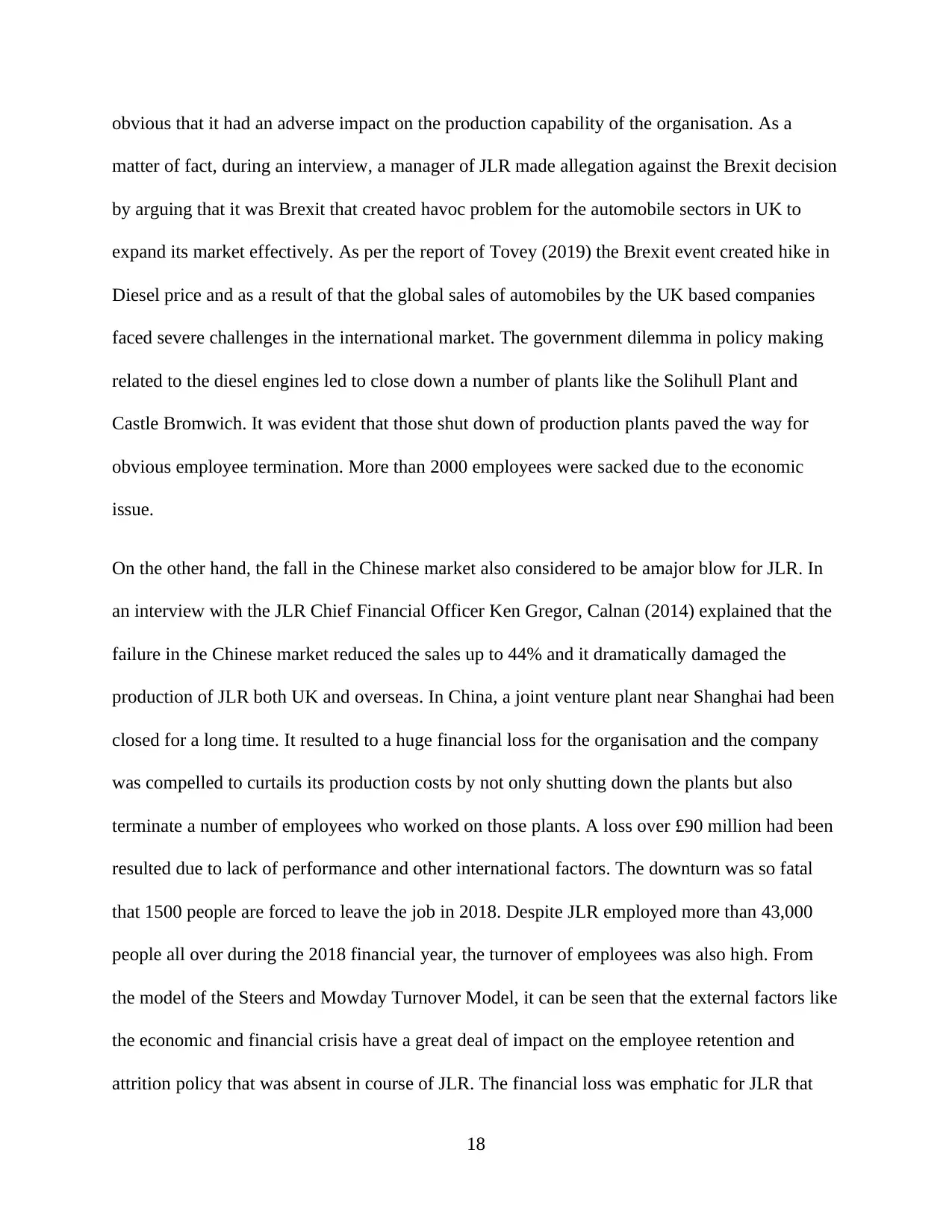
matter of fact, during an interview, a manager of JLR made allegation against the Brexit decision
by arguing that it was Brexit that created havoc problem for the automobile sectors in UK to
expand its market effectively. As per the report of Tovey (2019) the Brexit event created hike in
Diesel price and as a result of that the global sales of automobiles by the UK based companies
faced severe challenges in the international market. The government dilemma in policy making
related to the diesel engines led to close down a number of plants like the Solihull Plant and
Castle Bromwich. It was evident that those shut down of production plants paved the way for
obvious employee termination. More than 2000 employees were sacked due to the economic
issue.
On the other hand, the fall in the Chinese market also considered to be amajor blow for JLR. In
an interview with the JLR Chief Financial Officer Ken Gregor, Calnan (2014) explained that the
failure in the Chinese market reduced the sales up to 44% and it dramatically damaged the
production of JLR both UK and overseas. In China, a joint venture plant near Shanghai had been
closed for a long time. It resulted to a huge financial loss for the organisation and the company
was compelled to curtails its production costs by not only shutting down the plants but also
terminate a number of employees who worked on those plants. A loss over £90 million had been
resulted due to lack of performance and other international factors. The downturn was so fatal
that 1500 people are forced to leave the job in 2018. Despite JLR employed more than 43,000
people all over during the 2018 financial year, the turnover of employees was also high. From
the model of the Steers and Mowday Turnover Model, it can be seen that the external factors like
the economic and financial crisis have a great deal of impact on the employee retention and
attrition policy that was absent in course of JLR. The financial loss was emphatic for JLR that
18
Paraphrase This Document
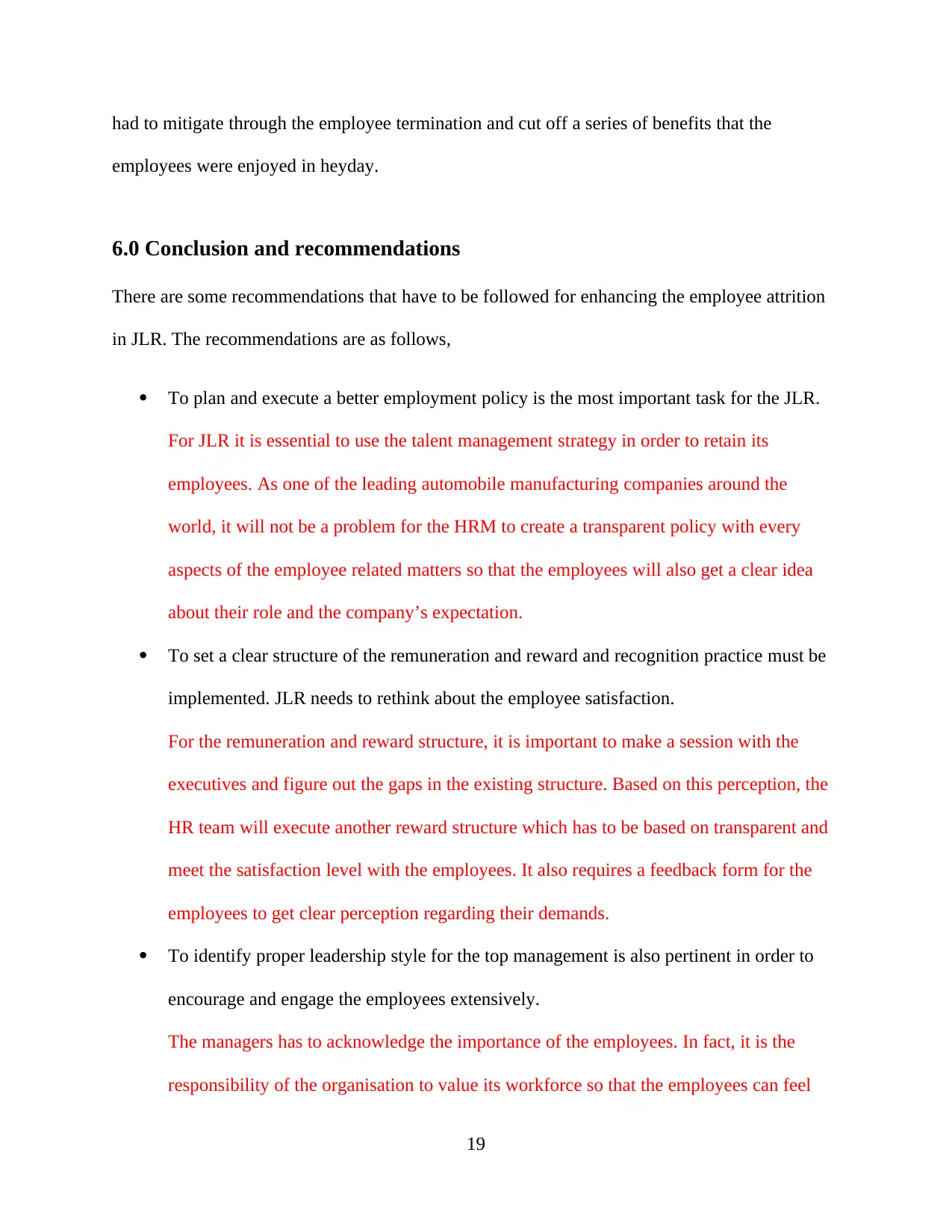
employees were enjoyed in heyday.
6.0 Conclusion and recommendations
There are some recommendations that have to be followed for enhancing the employee attrition
in JLR. The recommendations are as follows,
To plan and execute a better employment policy is the most important task for the JLR.
For JLR it is essential to use the talent management strategy in order to retain its
employees. As one of the leading automobile manufacturing companies around the
world, it will not be a problem for the HRM to create a transparent policy with every
aspects of the employee related matters so that the employees will also get a clear idea
about their role and the company’s expectation.
To set a clear structure of the remuneration and reward and recognition practice must be
implemented. JLR needs to rethink about the employee satisfaction.
For the remuneration and reward structure, it is important to make a session with the
executives and figure out the gaps in the existing structure. Based on this perception, the
HR team will execute another reward structure which has to be based on transparent and
meet the satisfaction level with the employees. It also requires a feedback form for the
employees to get clear perception regarding their demands.
To identify proper leadership style for the top management is also pertinent in order to
encourage and engage the employees extensively.
The managers has to acknowledge the importance of the employees. In fact, it is the
responsibility of the organisation to value its workforce so that the employees can feel
19
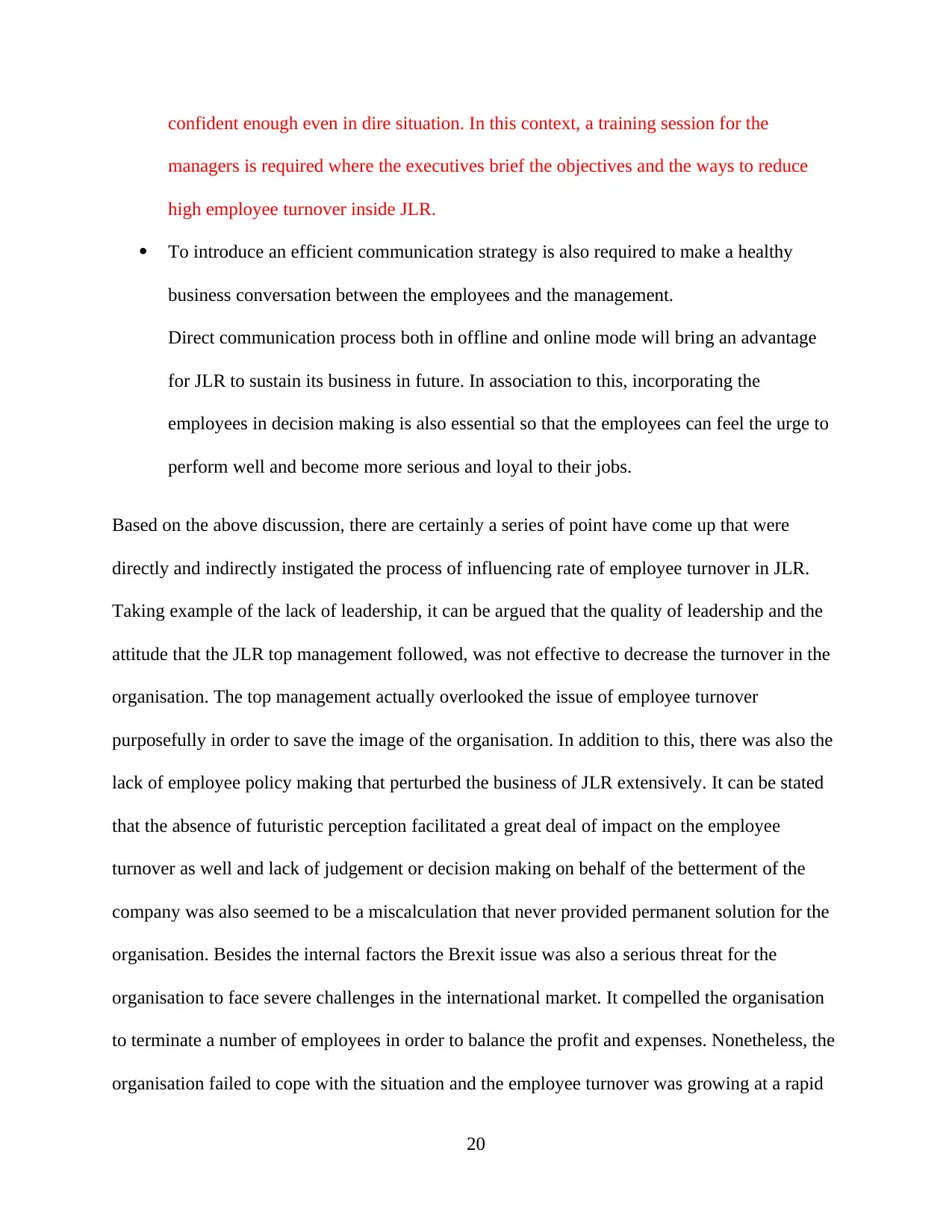
managers is required where the executives brief the objectives and the ways to reduce
high employee turnover inside JLR.
To introduce an efficient communication strategy is also required to make a healthy
business conversation between the employees and the management.
Direct communication process both in offline and online mode will bring an advantage
for JLR to sustain its business in future. In association to this, incorporating the
employees in decision making is also essential so that the employees can feel the urge to
perform well and become more serious and loyal to their jobs.
Based on the above discussion, there are certainly a series of point have come up that were
directly and indirectly instigated the process of influencing rate of employee turnover in JLR.
Taking example of the lack of leadership, it can be argued that the quality of leadership and the
attitude that the JLR top management followed, was not effective to decrease the turnover in the
organisation. The top management actually overlooked the issue of employee turnover
purposefully in order to save the image of the organisation. In addition to this, there was also the
lack of employee policy making that perturbed the business of JLR extensively. It can be stated
that the absence of futuristic perception facilitated a great deal of impact on the employee
turnover as well and lack of judgement or decision making on behalf of the betterment of the
company was also seemed to be a miscalculation that never provided permanent solution for the
organisation. Besides the internal factors the Brexit issue was also a serious threat for the
organisation to face severe challenges in the international market. It compelled the organisation
to terminate a number of employees in order to balance the profit and expenses. Nonetheless, the
organisation failed to cope with the situation and the employee turnover was growing at a rapid
20
⊘ This is a preview!⊘
Do you want full access?
Subscribe today to unlock all pages.

Trusted by 1+ million students worldwide
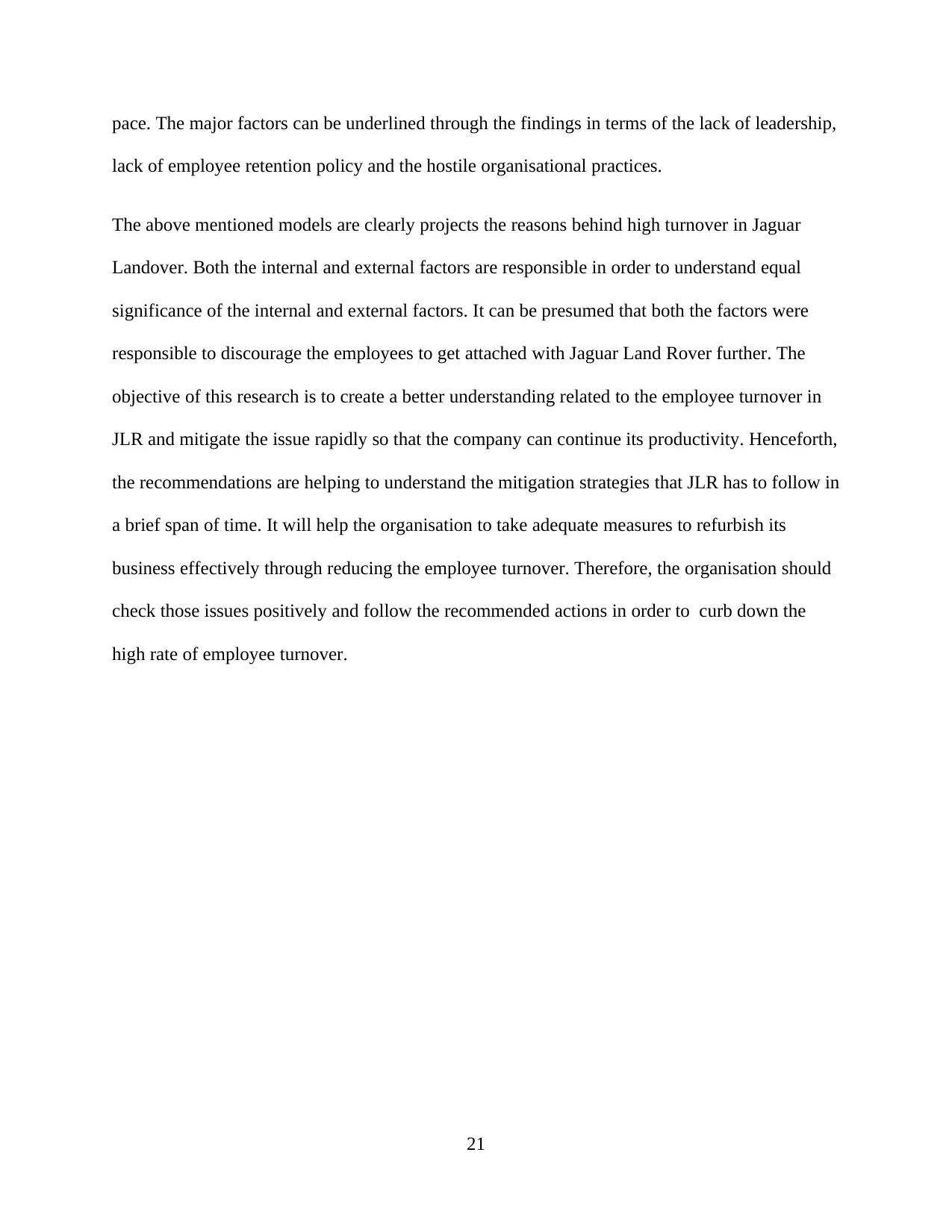
lack of employee retention policy and the hostile organisational practices.
The above mentioned models are clearly projects the reasons behind high turnover in Jaguar
Landover. Both the internal and external factors are responsible in order to understand equal
significance of the internal and external factors. It can be presumed that both the factors were
responsible to discourage the employees to get attached with Jaguar Land Rover further. The
objective of this research is to create a better understanding related to the employee turnover in
JLR and mitigate the issue rapidly so that the company can continue its productivity. Henceforth,
the recommendations are helping to understand the mitigation strategies that JLR has to follow in
a brief span of time. It will help the organisation to take adequate measures to refurbish its
business effectively through reducing the employee turnover. Therefore, the organisation should
check those issues positively and follow the recommended actions in order to curb down the
high rate of employee turnover.
21
Paraphrase This Document
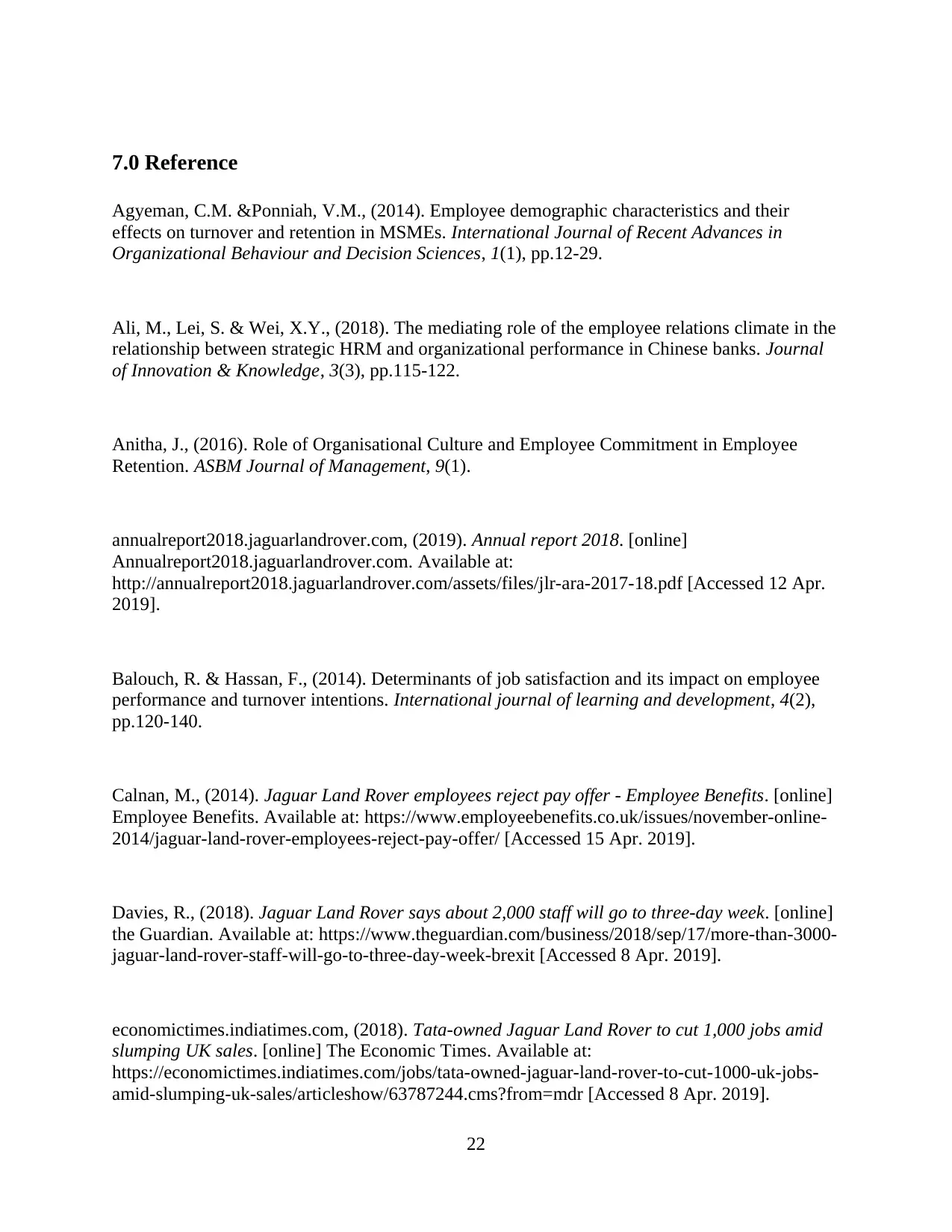
Agyeman, C.M. &Ponniah, V.M., (2014). Employee demographic characteristics and their
effects on turnover and retention in MSMEs. International Journal of Recent Advances in
Organizational Behaviour and Decision Sciences, 1(1), pp.12-29.
Ali, M., Lei, S. & Wei, X.Y., (2018). The mediating role of the employee relations climate in the
relationship between strategic HRM and organizational performance in Chinese banks. Journal
of Innovation & Knowledge, 3(3), pp.115-122.
Anitha, J., (2016). Role of Organisational Culture and Employee Commitment in Employee
Retention. ASBM Journal of Management, 9(1).
annualreport2018.jaguarlandrover.com, (2019). Annual report 2018. [online]
Annualreport2018.jaguarlandrover.com. Available at:
http://annualreport2018.jaguarlandrover.com/assets/files/jlr-ara-2017-18.pdf [Accessed 12 Apr.
2019].
Balouch, R. & Hassan, F., (2014). Determinants of job satisfaction and its impact on employee
performance and turnover intentions. International journal of learning and development, 4(2),
pp.120-140.
Calnan, M., (2014). Jaguar Land Rover employees reject pay offer - Employee Benefits. [online]
Employee Benefits. Available at: https://www.employeebenefits.co.uk/issues/november-online-
2014/jaguar-land-rover-employees-reject-pay-offer/ [Accessed 15 Apr. 2019].
Davies, R., (2018). Jaguar Land Rover says about 2,000 staff will go to three-day week. [online]
the Guardian. Available at: https://www.theguardian.com/business/2018/sep/17/more-than-3000-
jaguar-land-rover-staff-will-go-to-three-day-week-brexit [Accessed 8 Apr. 2019].
economictimes.indiatimes.com, (2018). Tata-owned Jaguar Land Rover to cut 1,000 jobs amid
slumping UK sales. [online] The Economic Times. Available at:
https://economictimes.indiatimes.com/jobs/tata-owned-jaguar-land-rover-to-cut-1000-uk-jobs-
amid-slumping-uk-sales/articleshow/63787244.cms?from=mdr [Accessed 8 Apr. 2019].
22
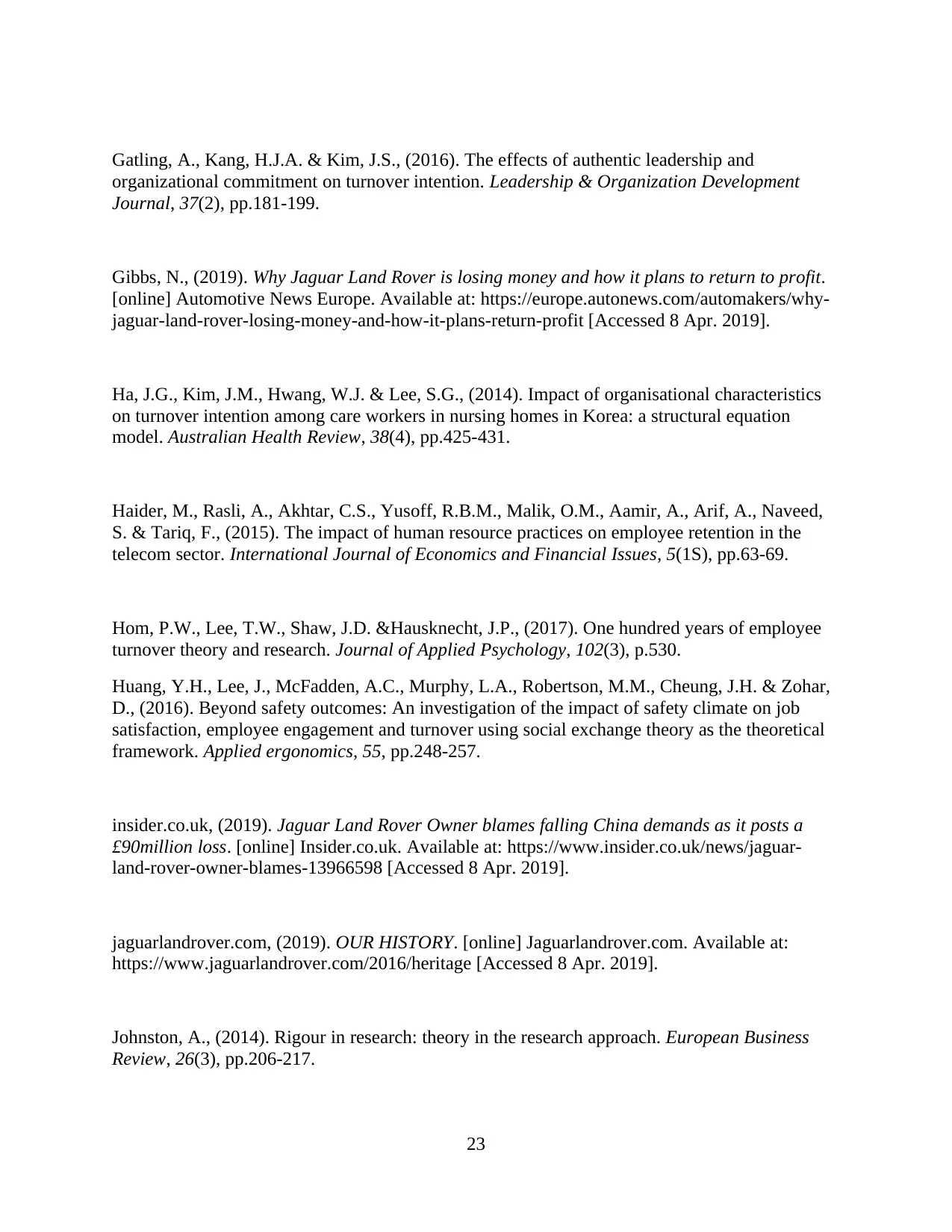
organizational commitment on turnover intention. Leadership & Organization Development
Journal, 37(2), pp.181-199.
Gibbs, N., (2019). Why Jaguar Land Rover is losing money and how it plans to return to profit.
[online] Automotive News Europe. Available at: https://europe.autonews.com/automakers/why-
jaguar-land-rover-losing-money-and-how-it-plans-return-profit [Accessed 8 Apr. 2019].
Ha, J.G., Kim, J.M., Hwang, W.J. & Lee, S.G., (2014). Impact of organisational characteristics
on turnover intention among care workers in nursing homes in Korea: a structural equation
model. Australian Health Review, 38(4), pp.425-431.
Haider, M., Rasli, A., Akhtar, C.S., Yusoff, R.B.M., Malik, O.M., Aamir, A., Arif, A., Naveed,
S. & Tariq, F., (2015). The impact of human resource practices on employee retention in the
telecom sector. International Journal of Economics and Financial Issues, 5(1S), pp.63-69.
Hom, P.W., Lee, T.W., Shaw, J.D. &Hausknecht, J.P., (2017). One hundred years of employee
turnover theory and research. Journal of Applied Psychology, 102(3), p.530.
Huang, Y.H., Lee, J., McFadden, A.C., Murphy, L.A., Robertson, M.M., Cheung, J.H. & Zohar,
D., (2016). Beyond safety outcomes: An investigation of the impact of safety climate on job
satisfaction, employee engagement and turnover using social exchange theory as the theoretical
framework. Applied ergonomics, 55, pp.248-257.
insider.co.uk, (2019). Jaguar Land Rover Owner blames falling China demands as it posts a
£90million loss. [online] Insider.co.uk. Available at: https://www.insider.co.uk/news/jaguar-
land-rover-owner-blames-13966598 [Accessed 8 Apr. 2019].
jaguarlandrover.com, (2019). OUR HISTORY. [online] Jaguarlandrover.com. Available at:
https://www.jaguarlandrover.com/2016/heritage [Accessed 8 Apr. 2019].
Johnston, A., (2014). Rigour in research: theory in the research approach. European Business
Review, 26(3), pp.206-217.
23
⊘ This is a preview!⊘
Do you want full access?
Subscribe today to unlock all pages.

Trusted by 1+ million students worldwide
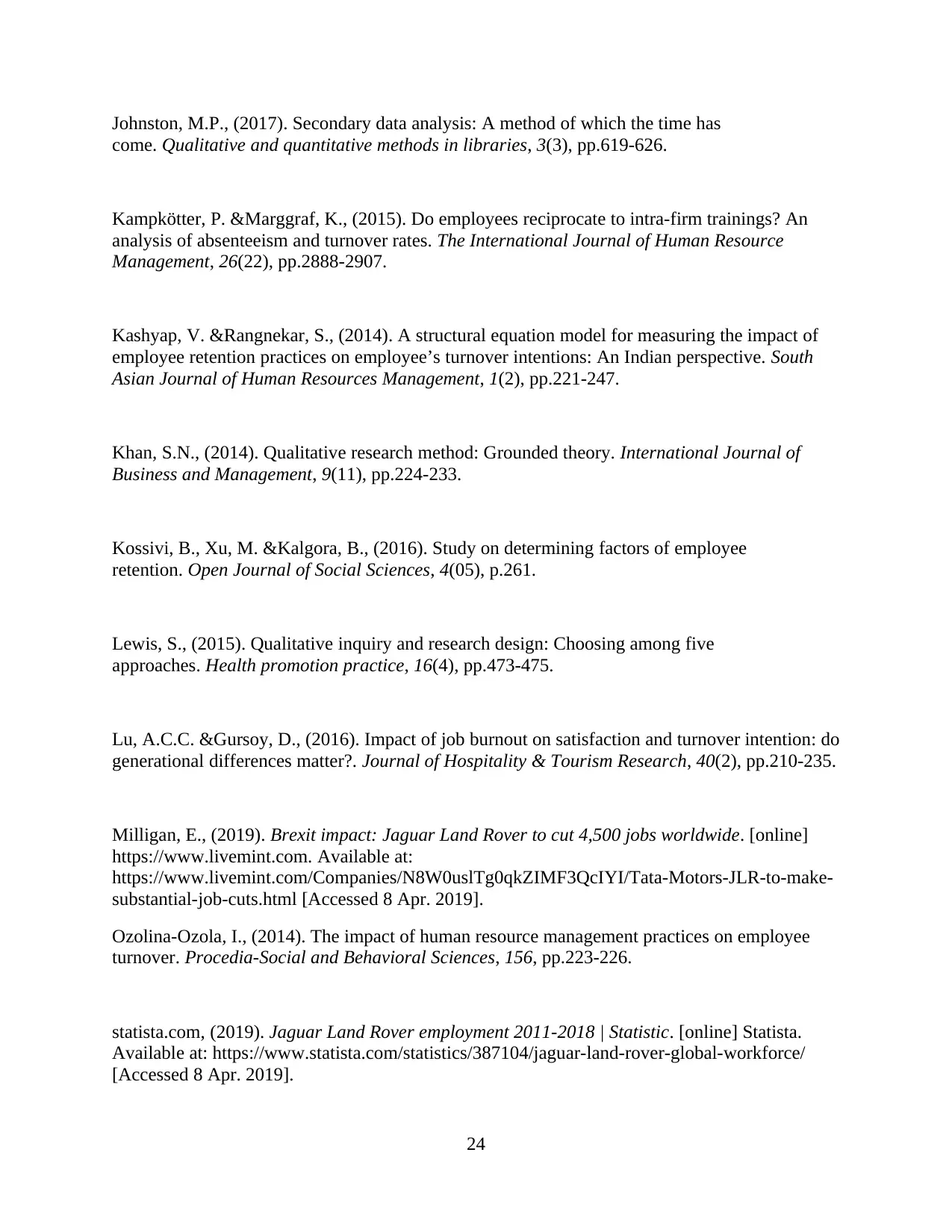
come. Qualitative and quantitative methods in libraries, 3(3), pp.619-626.
Kampkötter, P. &Marggraf, K., (2015). Do employees reciprocate to intra-firm trainings? An
analysis of absenteeism and turnover rates. The International Journal of Human Resource
Management, 26(22), pp.2888-2907.
Kashyap, V. &Rangnekar, S., (2014). A structural equation model for measuring the impact of
employee retention practices on employee’s turnover intentions: An Indian perspective. South
Asian Journal of Human Resources Management, 1(2), pp.221-247.
Khan, S.N., (2014). Qualitative research method: Grounded theory. International Journal of
Business and Management, 9(11), pp.224-233.
Kossivi, B., Xu, M. &Kalgora, B., (2016). Study on determining factors of employee
retention. Open Journal of Social Sciences, 4(05), p.261.
Lewis, S., (2015). Qualitative inquiry and research design: Choosing among five
approaches. Health promotion practice, 16(4), pp.473-475.
Lu, A.C.C. &Gursoy, D., (2016). Impact of job burnout on satisfaction and turnover intention: do
generational differences matter?. Journal of Hospitality & Tourism Research, 40(2), pp.210-235.
Milligan, E., (2019). Brexit impact: Jaguar Land Rover to cut 4,500 jobs worldwide. [online]
https://www.livemint.com. Available at:
https://www.livemint.com/Companies/N8W0uslTg0qkZIMF3QcIYI/Tata-Motors-JLR-to-make-
substantial-job-cuts.html [Accessed 8 Apr. 2019].
Ozolina-Ozola, I., (2014). The impact of human resource management practices on employee
turnover. Procedia-Social and Behavioral Sciences, 156, pp.223-226.
statista.com, (2019). Jaguar Land Rover employment 2011-2018 | Statistic. [online] Statista.
Available at: https://www.statista.com/statistics/387104/jaguar-land-rover-global-workforce/
[Accessed 8 Apr. 2019].
24
Paraphrase This Document
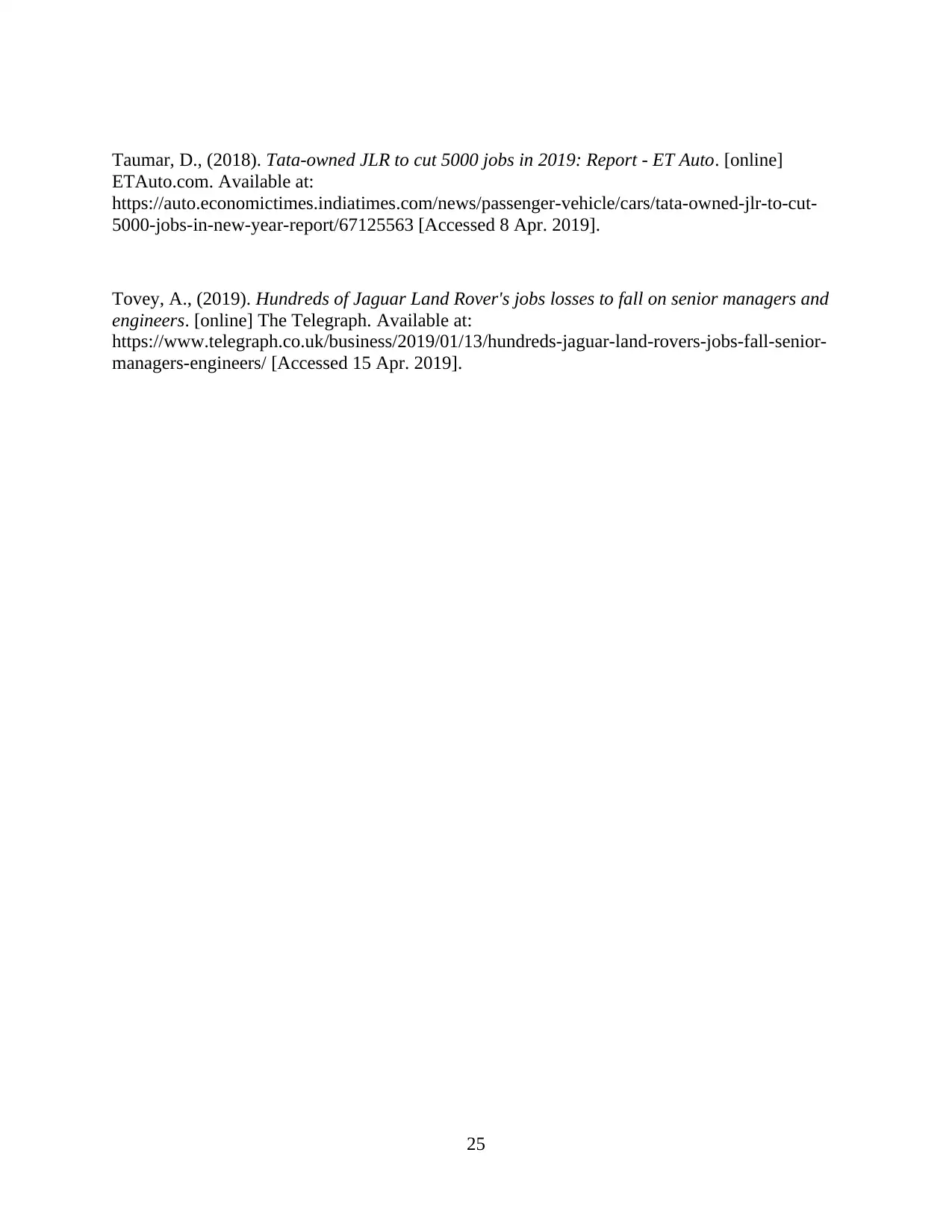
ETAuto.com. Available at:
https://auto.economictimes.indiatimes.com/news/passenger-vehicle/cars/tata-owned-jlr-to-cut-
5000-jobs-in-new-year-report/67125563 [Accessed 8 Apr. 2019].
Tovey, A., (2019). Hundreds of Jaguar Land Rover's jobs losses to fall on senior managers and
engineers. [online] The Telegraph. Available at:
https://www.telegraph.co.uk/business/2019/01/13/hundreds-jaguar-land-rovers-jobs-fall-senior-
managers-engineers/ [Accessed 15 Apr. 2019].
25
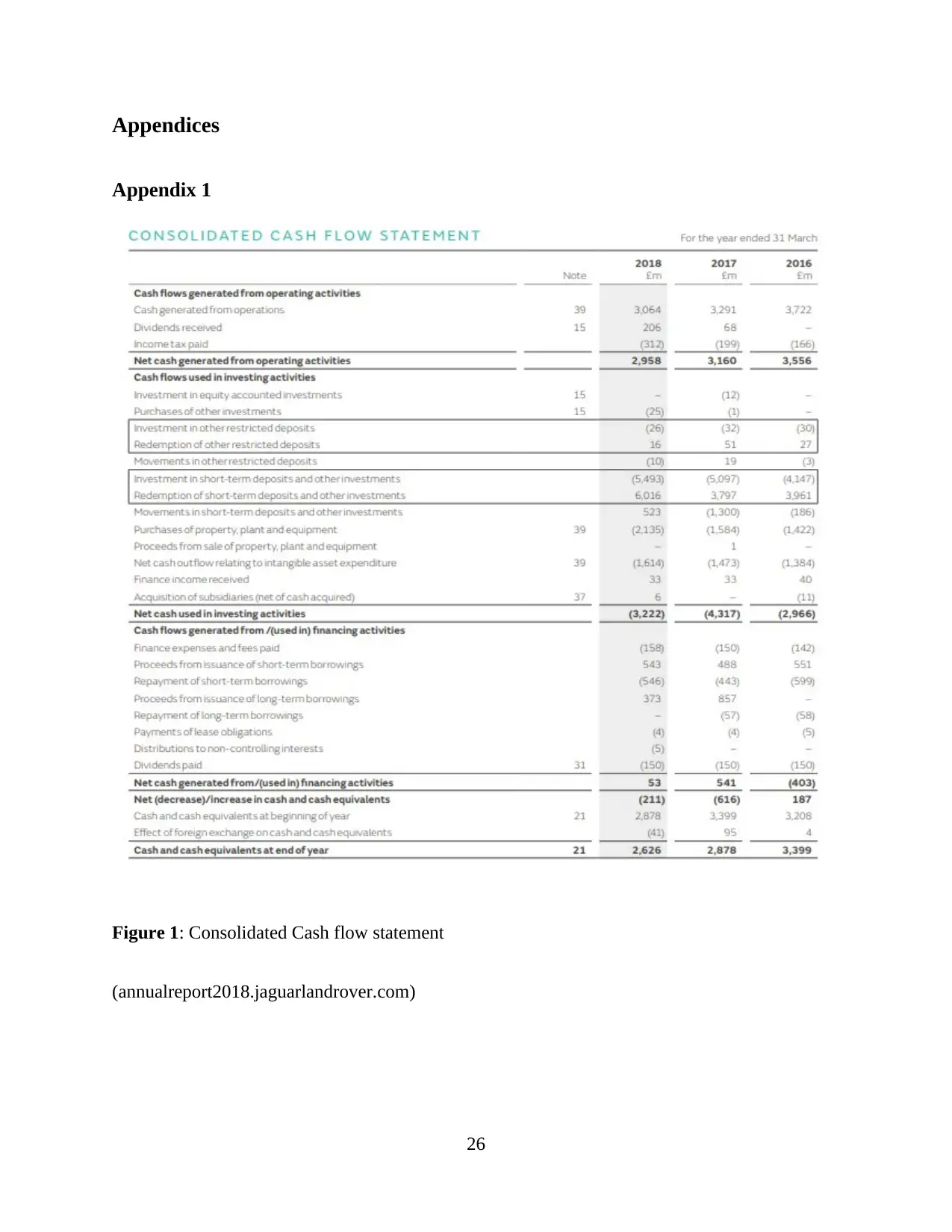
Appendix 1
Figure 1: Consolidated Cash flow statement
(annualreport2018.jaguarlandrover.com)
26
⊘ This is a preview!⊘
Do you want full access?
Subscribe today to unlock all pages.

Trusted by 1+ million students worldwide
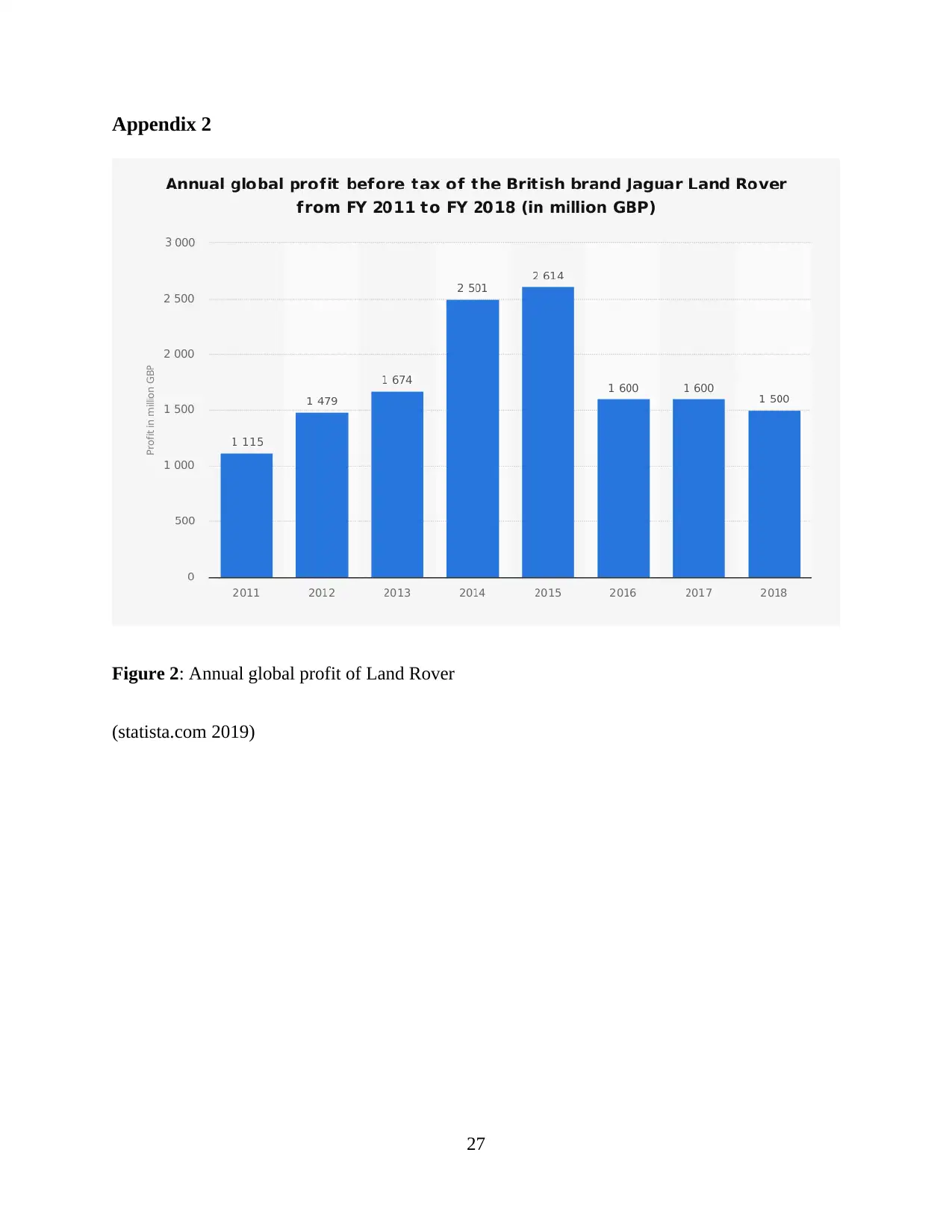
Figure 2: Annual global profit of Land Rover
(statista.com 2019)
27
Paraphrase This Document

Figure 3: Decreasing rate of JLR in China
(statista.com 2019)
Appendix 4
Figure 4: Annual sales report of JLR 2002-2014
(Davies 2018)
28
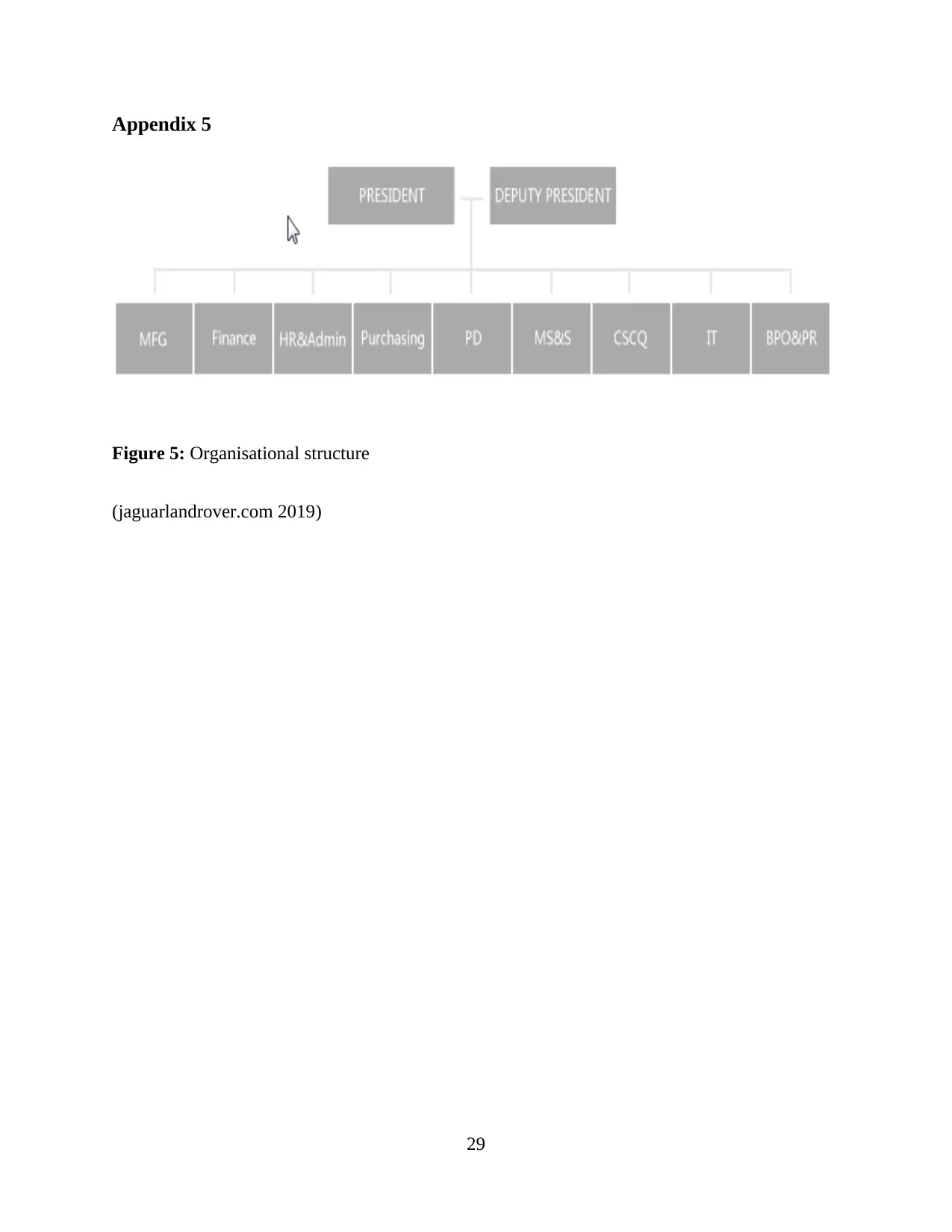
Figure 5: Organisational structure
(jaguarlandrover.com 2019)
29
⊘ This is a preview!⊘
Do you want full access?
Subscribe today to unlock all pages.

Trusted by 1+ million students worldwide
Your All-in-One AI-Powered Toolkit for Academic Success.
+13062052269
info@desklib.com
Available 24*7 on WhatsApp / Email
![[object Object]](/_next/static/media/star-bottom.7253800d.svg)
© 2024 | Zucol Services PVT LTD | All rights reserved.